All, Learn
We cannot recommend overland travel enough. Read through our last 6 months of blog posts and you’ll see why. Overland travel on public transport is probably the closest you can get to experiencing a country in its authentic entirety, the good bits and the bad bits all thrown in together as you shoot by bullet train or meander by river ferry through this wonderful planet’s outstretched landscapes giving you a real feeling of geography and distance.
Sites such as www.seat61.com have been incredibly helpful. Mark – thank you, we don’t know you but you’ve saved us many a headache. But it seems that eastern Indonesia is still rather adventurous territory due to the lack of trains because, well, it’s all a bit of a hotch potch of islands with ocean in between. After finding our way along this green line marked on the out-of-date-but-only-available national Pelni ferry map, we would like to share our findings with you, dear adventurous reader just chomping on the bit to get off on your next trip – we can guarantee one thing, it’s going to be an experience to tell your grand kids about.
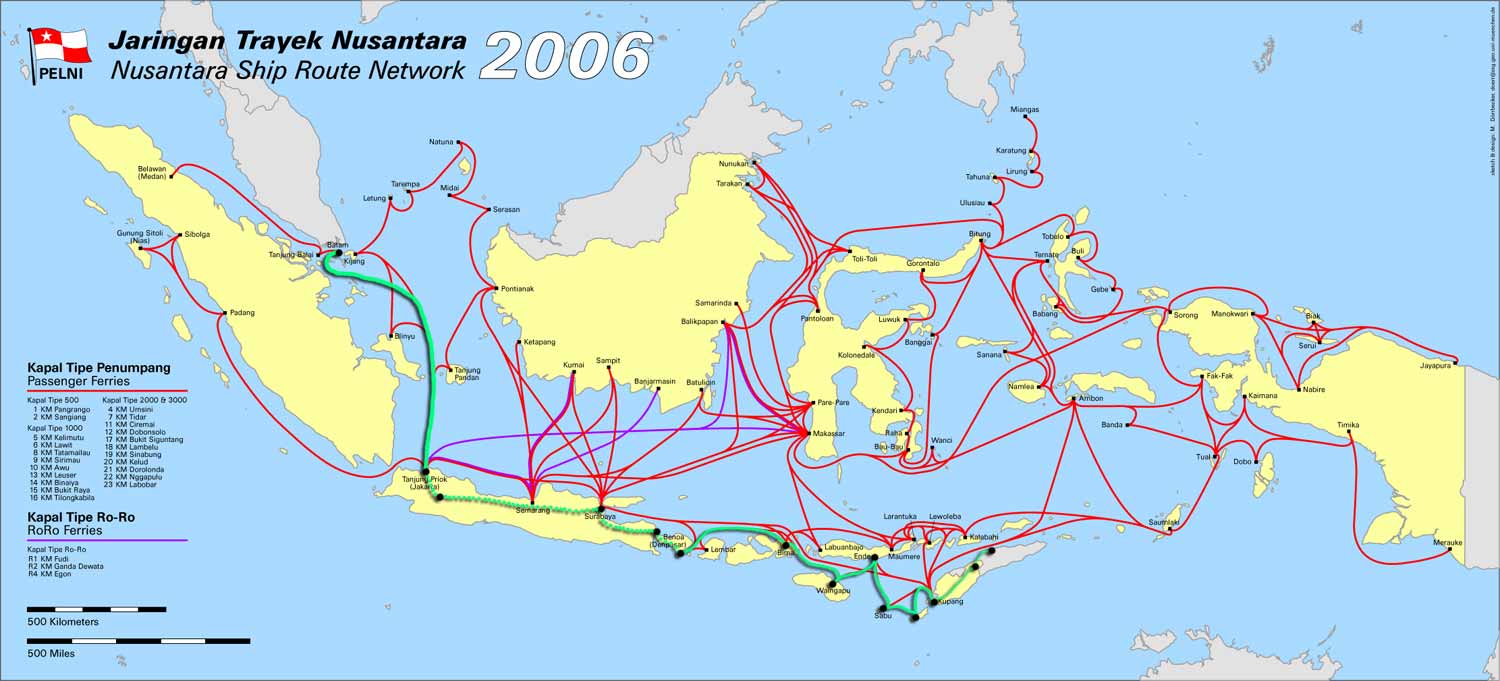
Pelni is the Indonesian public ferry operator, who still offer most routes on the map above. Check your preferred route well in advance as ferries usually only run once a week or (in the Bali-Kupang route) once every 3 weeks. To find out when the next ferry is due, check the Pelni website, make sure to select the little union jack (although this will only change some of the words into English) and then select your start port and destination in the ‘Ship Departure Schedule Search’ (‘Pencarian Jadwal Keberangkatan Kapal’ if English isn’t working) in the middle on the left. Make sure to set the date range pretty wide to be able to capture these infrequent services in your search. Check preliminary availability and rough prices by clicking ‘fare table’.
Note that you sometimes have to have a crystal ball to know what your destination port is called, as it’s not always the same as the city name. For example, if you want to arrive in Bali, don’t look for ‘Bali’ or ‘Denpasar’, you need to look for ‘Benoa’. If you’re choosing a different route to the one we’re describing, you may have to do a little bit of detective work on google. It was possible to find out about schedules via phone ( +62 (0)21 791 80 606), but not find out what different classes included or to book tickets, which we were only able to get from the local offices. But more of that later.
So here you have it: the Rat & Dragon step by step guide to travelling overland from Singapore to Timor and beyond. All prices at time of writing, i.e. June/July 2014. DISCLAIMER: We would love you to have the best holiday in the world, so please always check these details locally as embarkation locations may change randomly (this is Indonesia, remember!). Otherwise, enjoy!
Singapore to Jakarta: Pelni Ferry
1) Ferry Singapore (Harbourfront) to Batam (Sekupang), 1 hour, SGD 35 pp

Take the underground to Harbourfront, fight your way through the endless maze of Gucci, Prada, Tiffany’s and Davidoff to the ferry terminal. Acquire ticket to Batam (Sekupang) on the 3rd level of the ferry terminal (there are various companies offering several crossings a day to different ports, make sure to chose Sekupang) and resist the temptation to pick up a special promotion Samsonite trolly suitcase from the stand in the middle of the terminal. Board the ferry, it should look something like this:
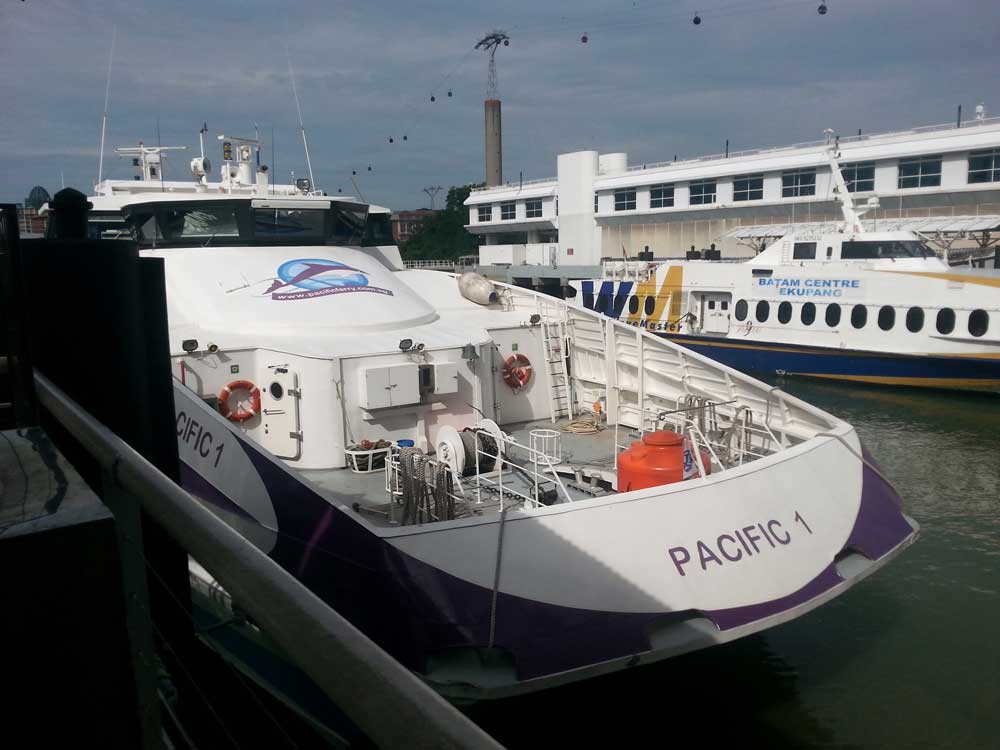
Congratulations, you have arrived on Batam Island, (the port is called Sekupang – we’ll put the port name behind the place name, if different, in parenthesis from now on) and in one hour have made it from Singapore to a completely new country: Indonesia. Give yourself a pat on the back.
2) Pelni ferry Batam (Pulau Batam) to Jakarta (Tanjung Priok), 30 hours, 2nd class: IDR 517’500 pp
Once on Batam Island, make sure you have enough cash (Pelni don’t do cards here, there’s an ATM in the terminal building), leave Sekupang terminal and head out to the road in search of the Pelni office. The address is on Jalan RE Martadinata – Jl. Dr. Cipto Mangunkusumo No.4, (Phone: 0778321070) but there are about 5 roads all called this. Here are pretty pictures in stead. Don’t be fooled by the google map windiness of the road, we found it to be quite straight and a little bit of a walk with the backpacks but certainly not worth getting ripped off by a persistent taxi driver at Sekupang terminal.
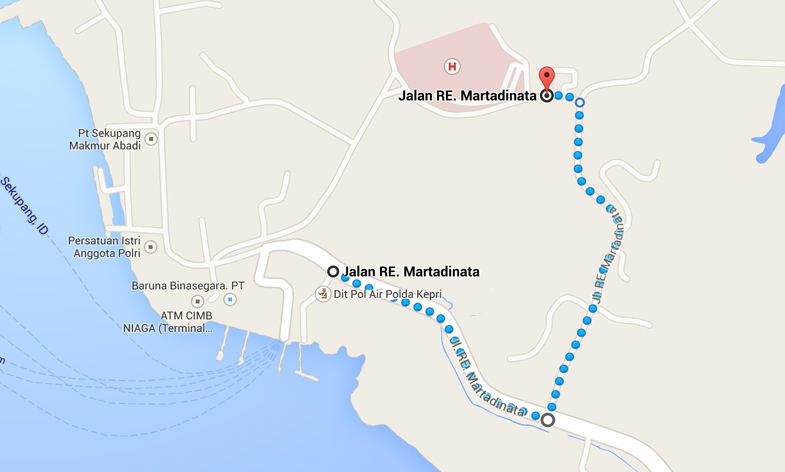
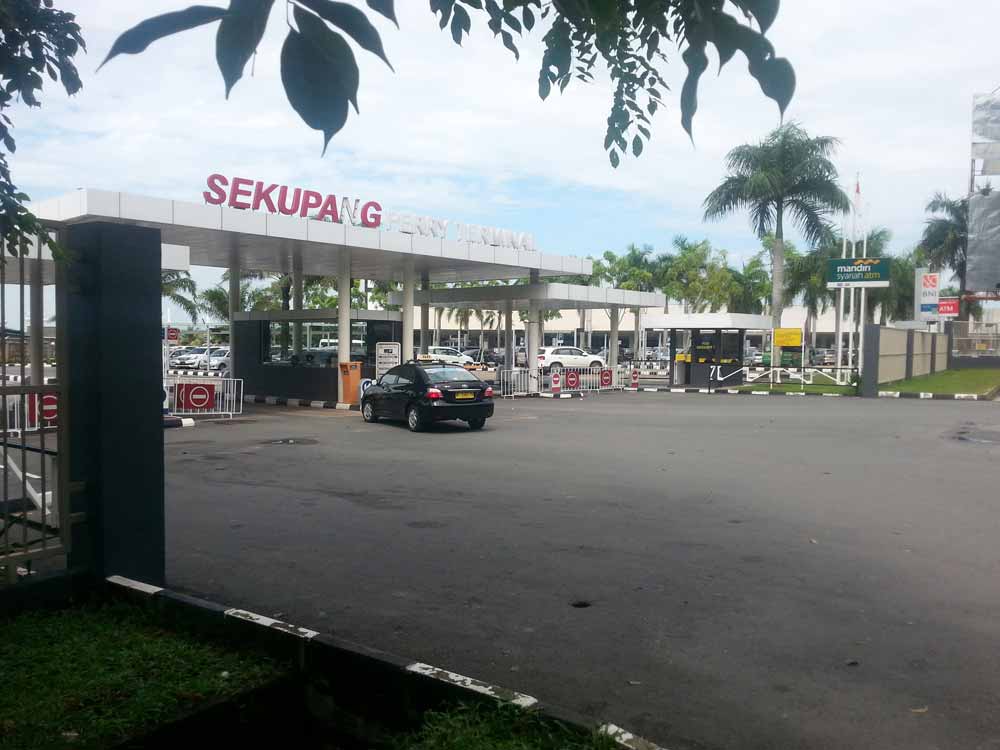
Turn right after heading out of Sekupang Terminal car park. Strike your best ‘I’m a tourist’ pose (no use denying it, you’ll never pass as a local)…
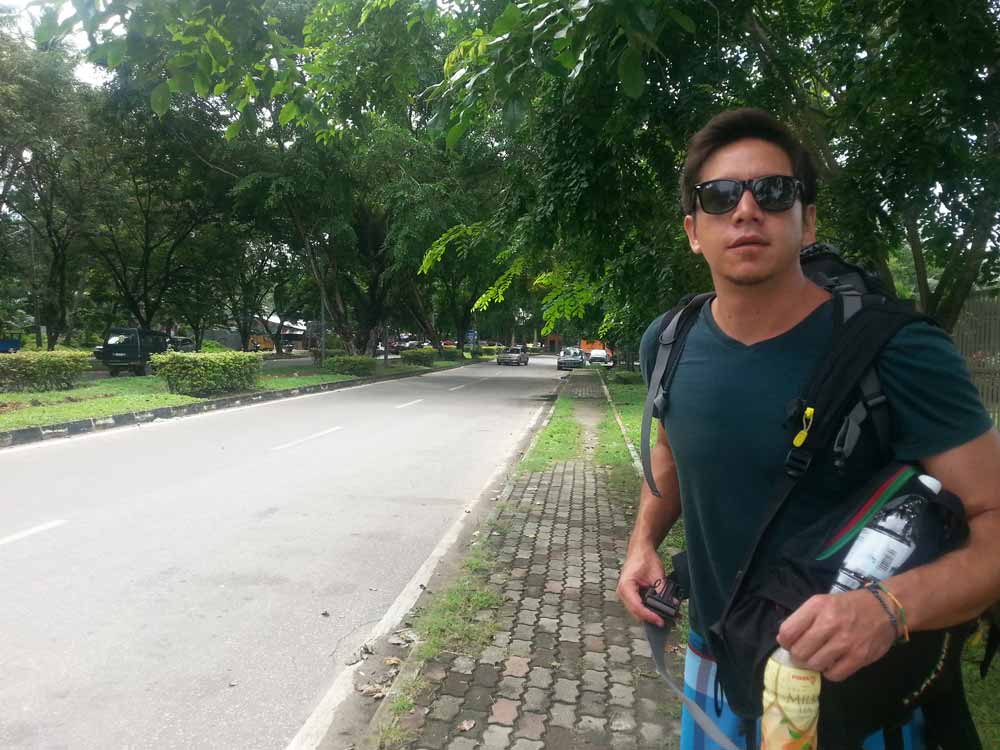
…and head down the road until you reach these old toll/security gates.
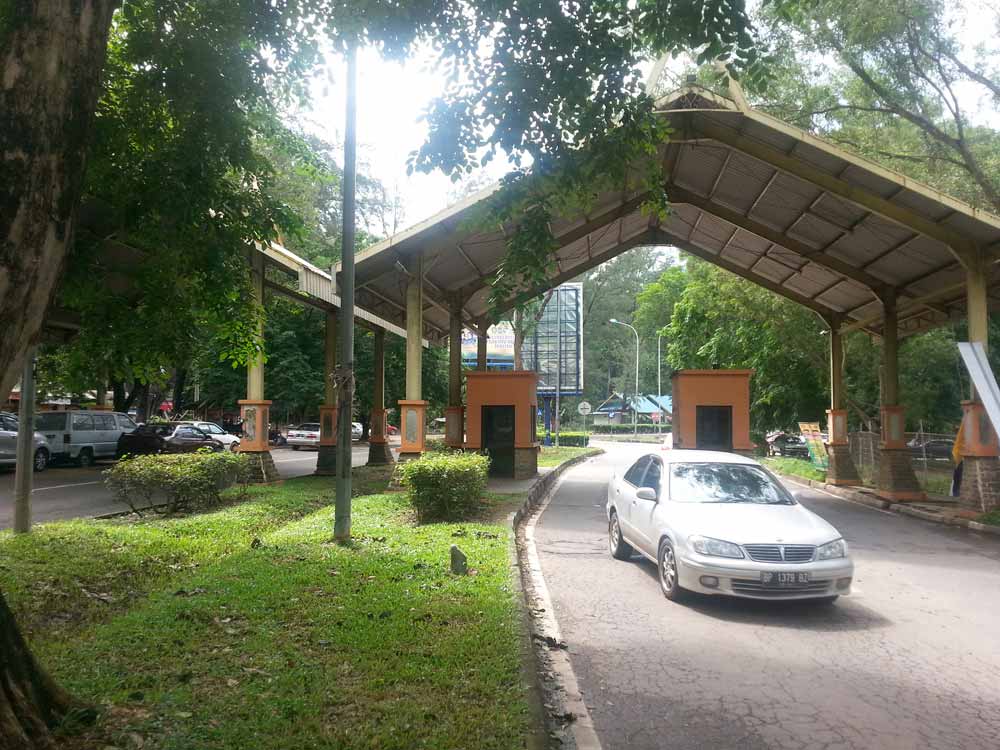
Turn left up the next road (it’s quite long, wide and empty), engage in banter with the taxi drivers hanging out on the corner but don’t believe them when they tell you it’s an hour’s walk to the Pelni office. It is not.
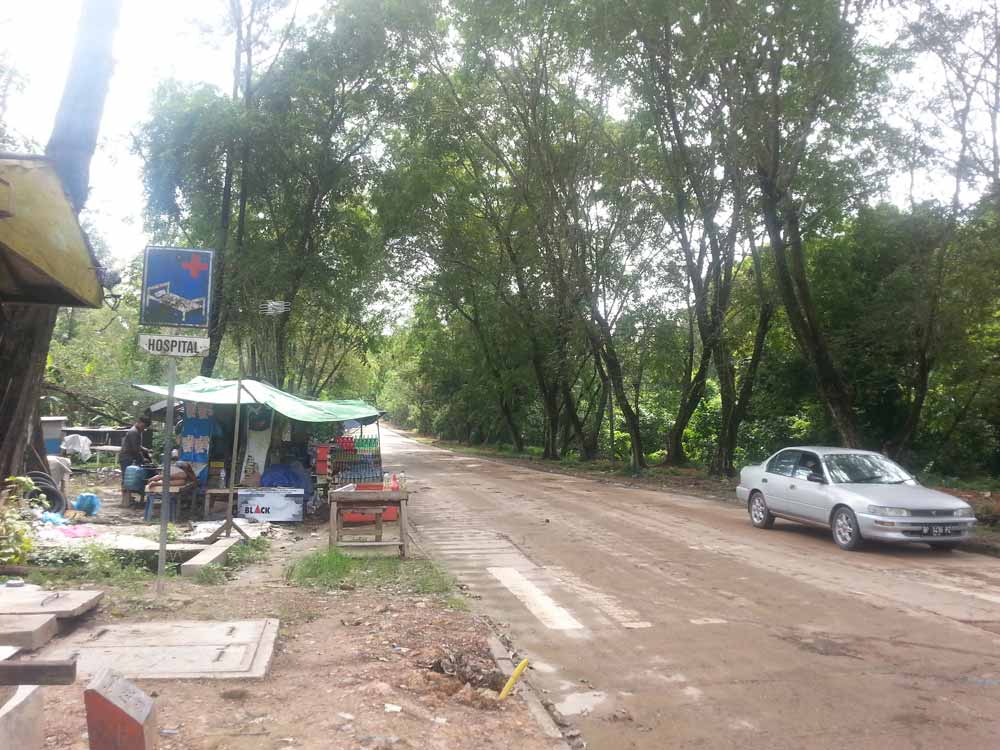
We wouldn’t recommend this particular hospital establishment, but get some water if you’re thirsty (check it’s still got plastic wrapping around the top). Head up this road…
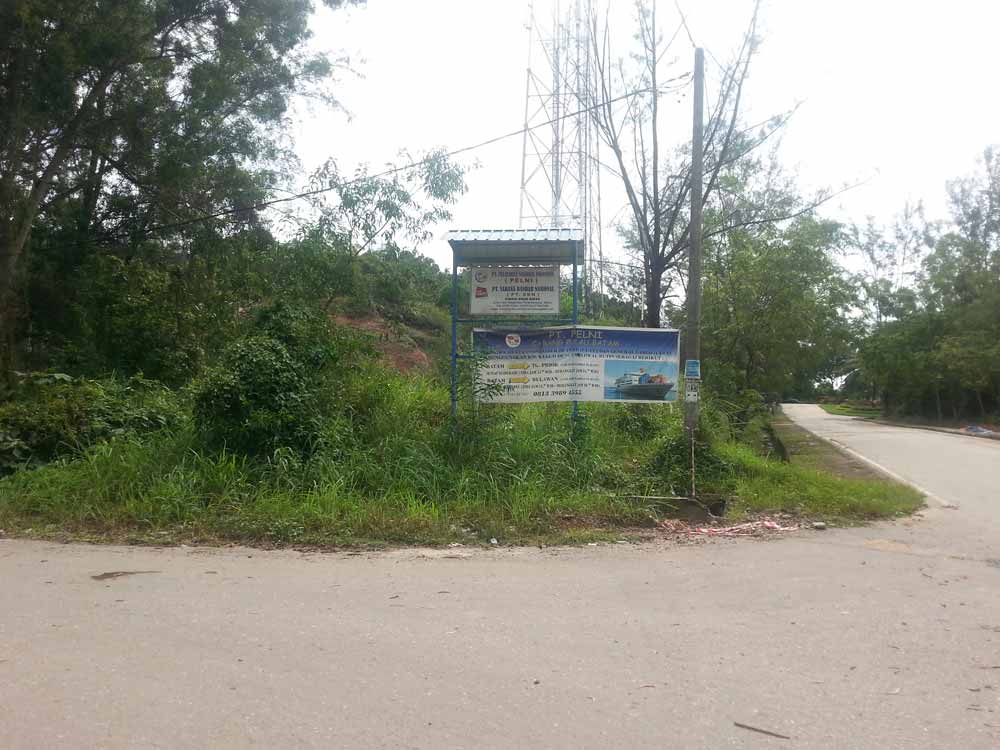
…until you get to a left turn. If you look closely, you’ll see this washed out Pelni sign at the junction. Turn onto this road.
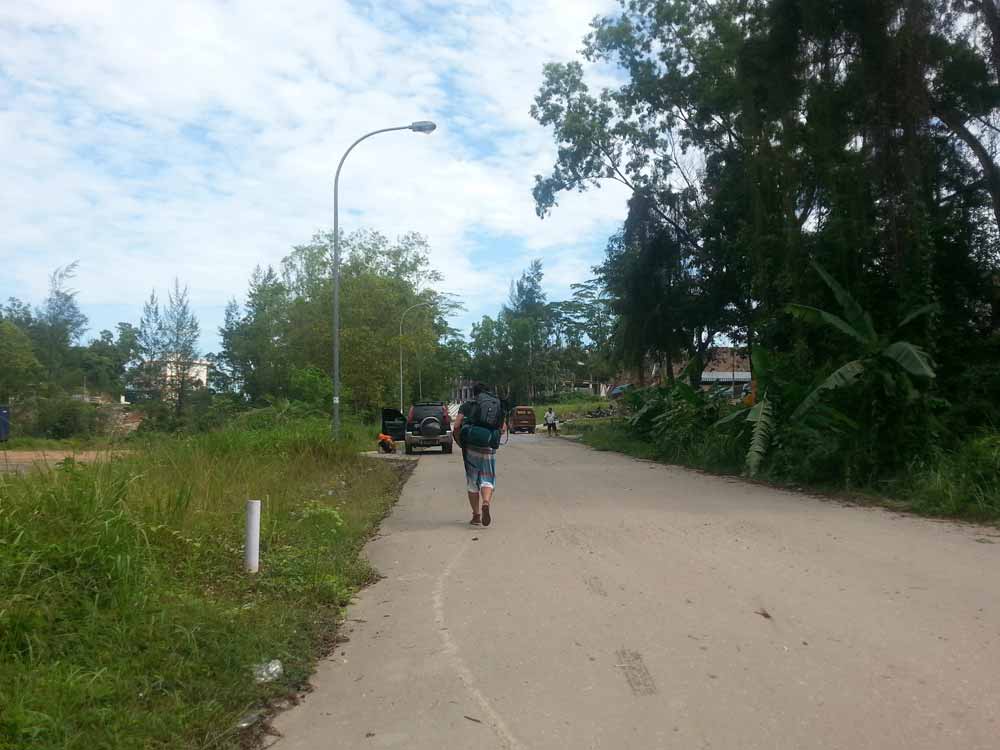
About 100m on your right, there will be a house with similar signage (you can see it peaking through the trees on the right of the picture above).
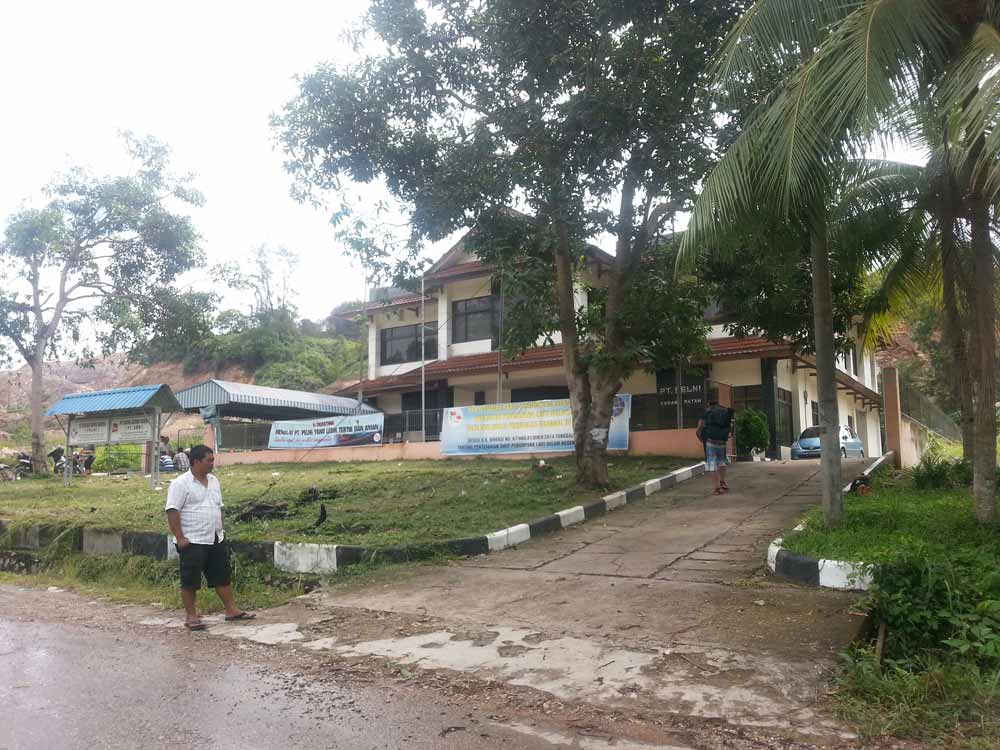
Engage in random banter with dude in white t-shirt. Then proceed to the blue and white striped awning and tell everyone in the queue you want to buy a ticket or you won’t be seen by the ticket vendor behind the grimy window. There was no way for us to buy tickets in advance or check their availability, so we had to take a leap of faith and just go very early on the day of departure and hope there were some left.
We got lucky and paid IDR 517’500 per person for a 2nd class berth, which is way cheaper than advertised on their website. Maybe our student IDs helped. 2nd class is gender segregated but we were around the corner from each other, sharing with 7 others per room (see pic later). Alternatives would have been a first class cabin each at IDR 1’628’000 (whether they let men and women share a cabin is up to the officer/captain on that day, we weren’t allowed to share) or economy class at IDR 415’000 which is a mattress space on the floor in a big room (or cardboard in the corridor/stairwell if you’re not fast enough – check out this blog for pics). Due to our need to lock up our kit, we chose the cabin, although for one night the ‘dorm’ would definitely have been an adventure.

Next step was heading to the Pulau Batam departure terminal and kill time until our scheduled departure at 5pm. Head back down to the Sekupang terminal you arrived at, thank the taxi dudes for their kind offers to rip you off earlier. In stead of going into the car park, keep straight on past it until the road curves to your right by a big white water tank.
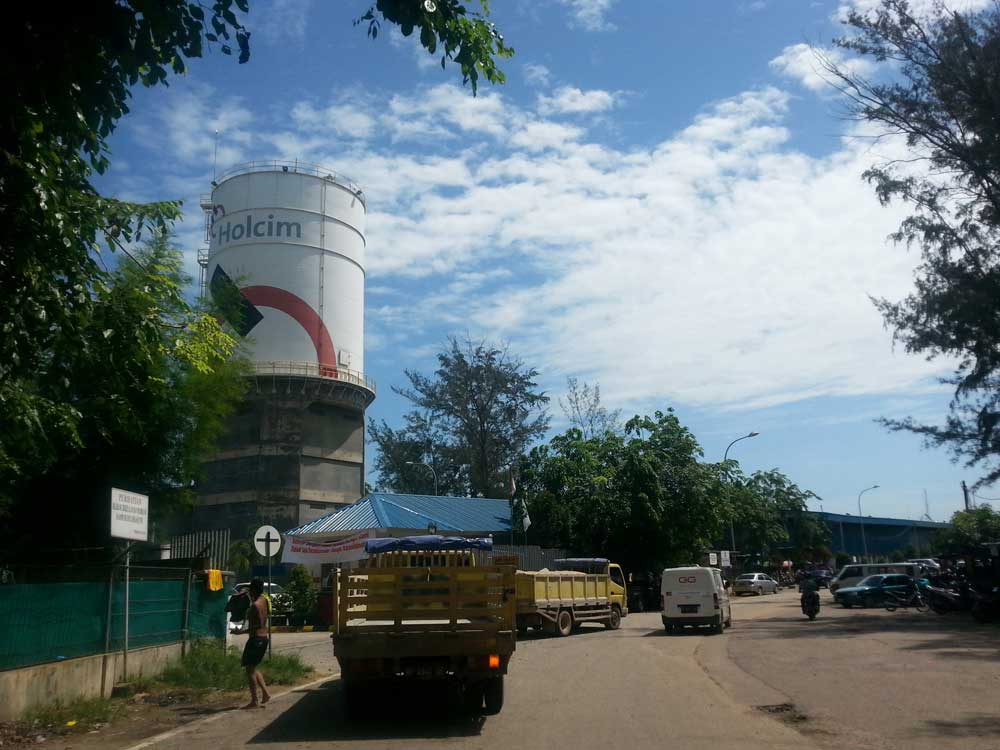
Keep going until you spot a large blue warehouse type building on your left (seen in the right hand corner of the pic above). This is the waiting area for Pelni’s ‘Pulau Batam’ – note it is ram-packed with people (yes, there are that many people waiting to get on a ferry with you).
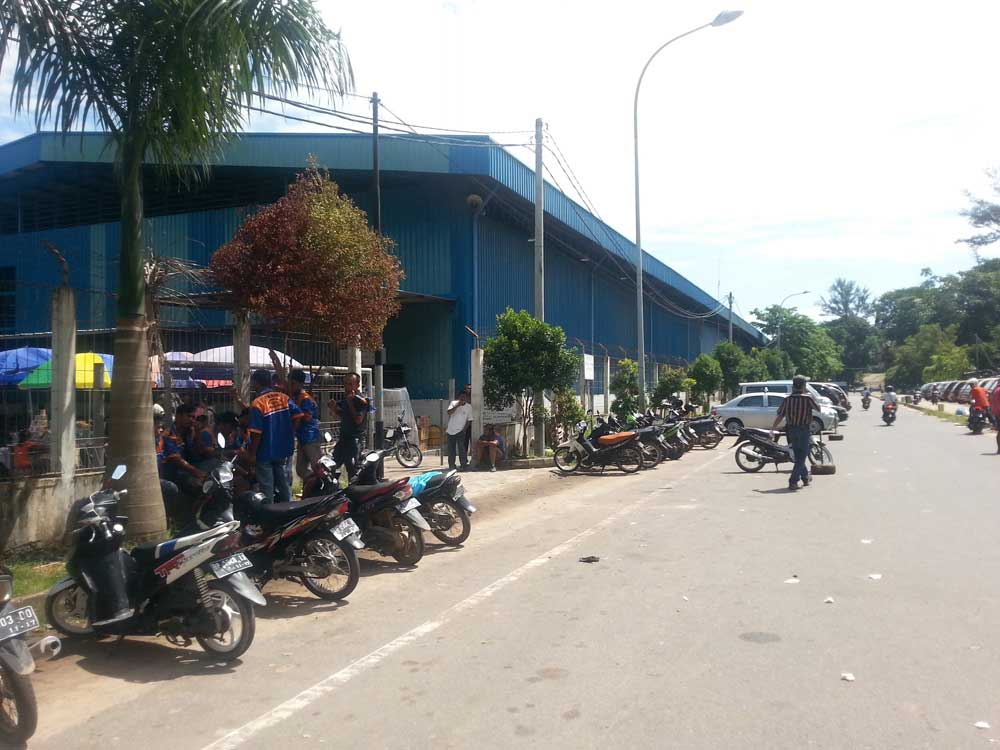
Enter past the guard, we chose to sit outdoors because it was a) pretty warm so everyone inside was sweating their proverbial bits off, b) the outdoors view was much nicer for the 8 hours we had ahead, c) no one was going anywhere for quite some time and d) there was a Bakso man playing twinkly music.
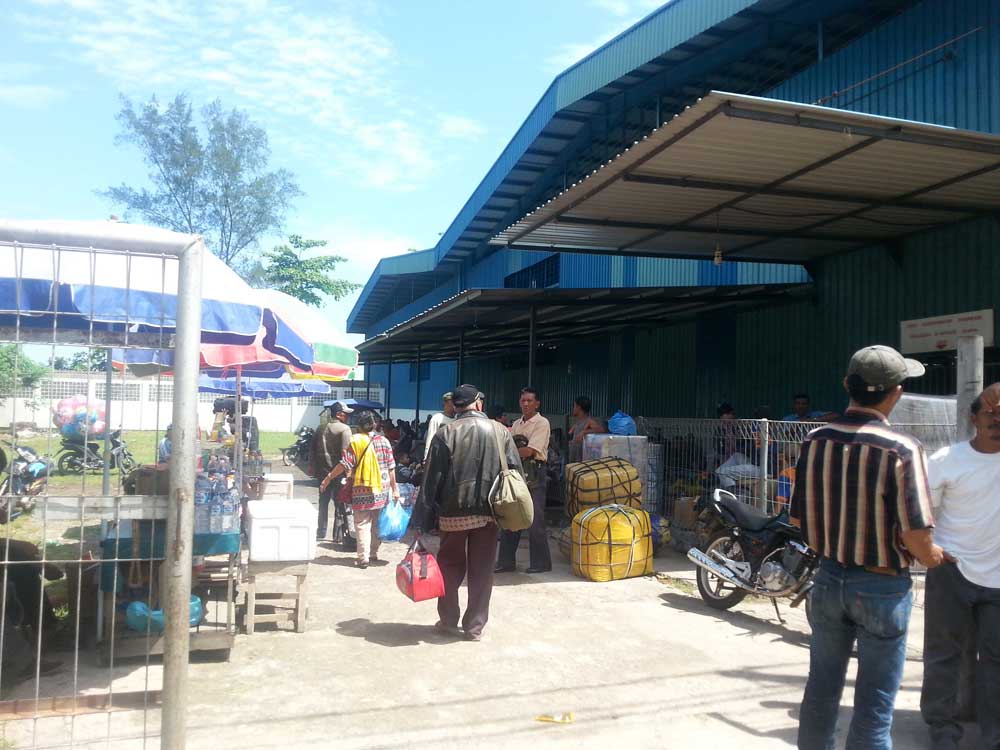
Purchase breakfast, lunch and snacks from ladies on the left. Purchase colourful bouncy ball that almost immediately deflates from scooter at the back. Wait. Send friend back to Sekupang terminal to buy cold water and Indonesian SIM cards. We found SIMpati good – vendors will usually charge you a service fee made up on the spot, so for IDR 10’000 credit, you’ll have to pay 12’000 and so on. You can get blocks of 1 week unlimited mobile data though, which is fantastic as we used our phones as mobile tethering hotspots so were able to do a lot of work on our laptops. Get the vendor to set it up, they may need to download some software, and credit needs to be allocated especially to internet usage. Make sure it works before leaving the shop. Wait some more.
Finally around 5pm, we were funnelled through the warehouse down a very narrow walkway area at the back and out to the harbour. Everyone made a game out of seeing how far they could push, or if they could queue-jump by legging it over the razor wired pier gate. Varying degrees of raucous laughter ensued. Prepare to be squashed.
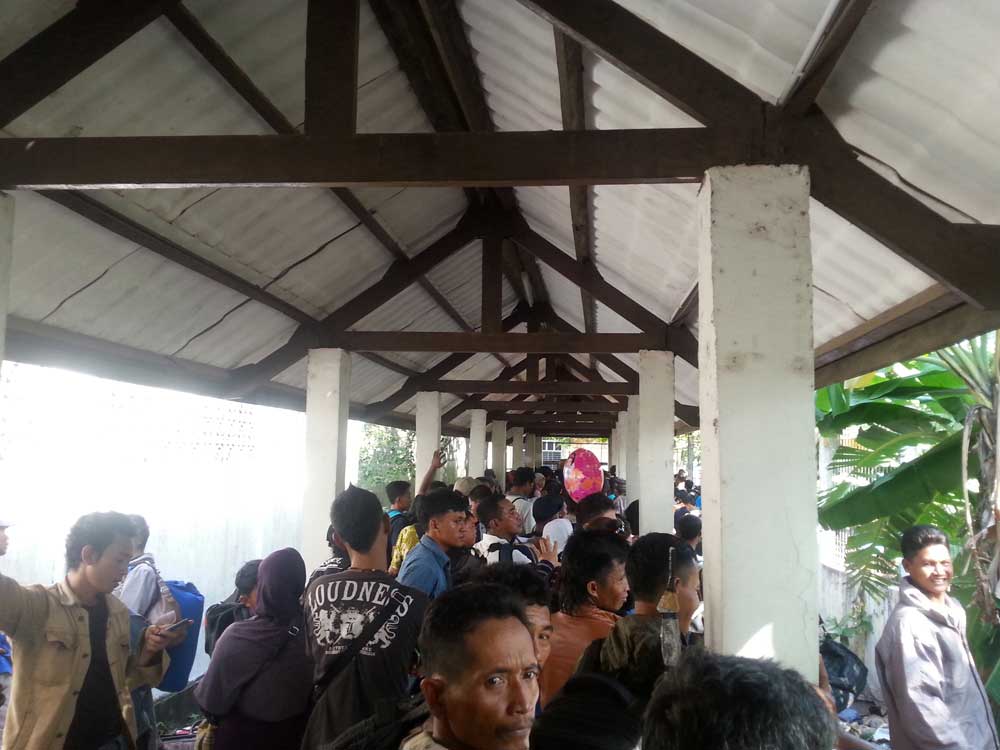
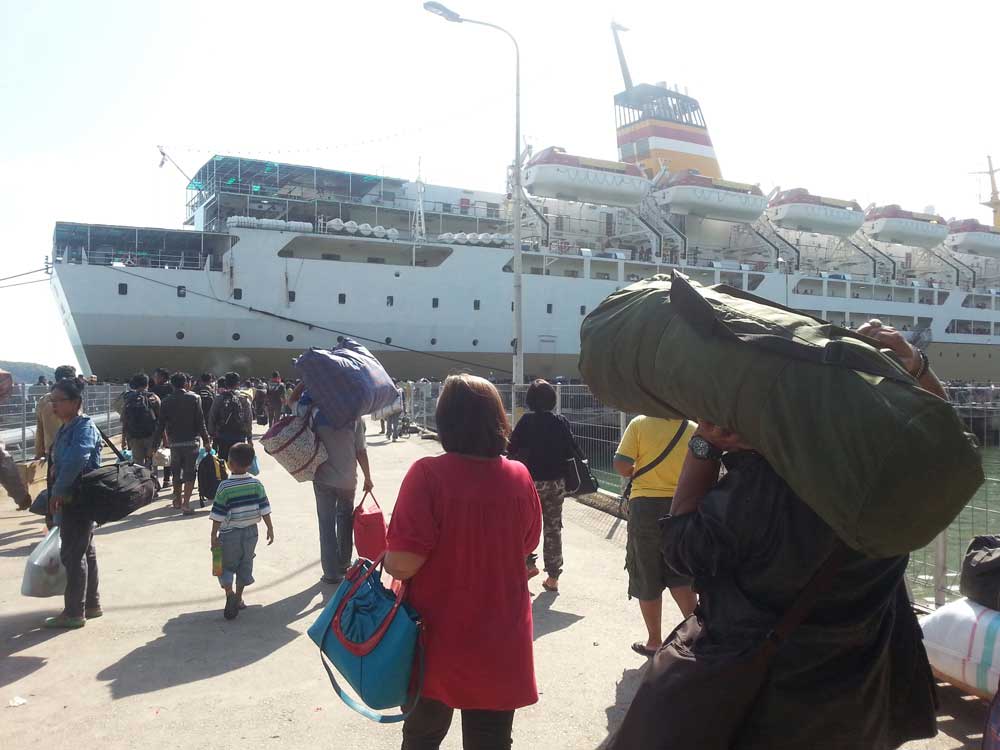
OUR BOAT!!
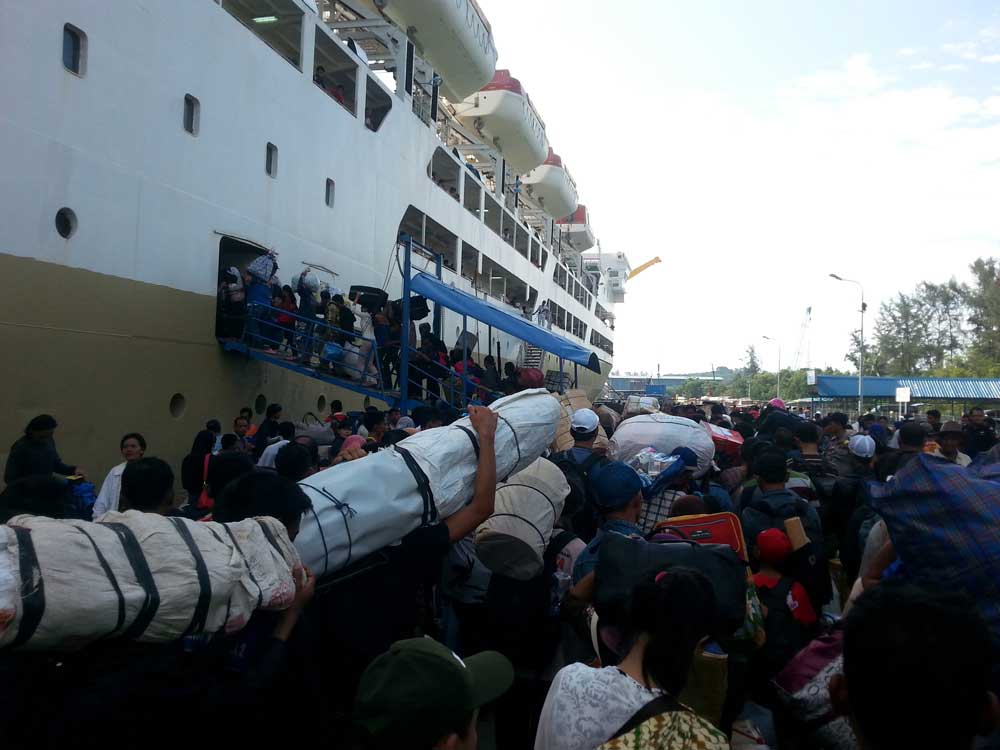
Added fun-factor by the boat: a) try to not miss the gangplank whilst being squeezed around and out of the throng, b) try to not fall in the water. Think of the whole thing as a mass-hug.

One of our rooms before everyone else got there. Ask the ferry reception for a bed with a lockable locker (only half the beds have them) and most beds didn’t have blankets, so we improvised. It was quite crowded once all beds were full, but otherwise a lot more luxurious than expected.

Make instant friends on deck and have a look around before everyone takes up all the space with makeshift beds on every available floor space. The family sleeping, cooking and generally living in the little corridor in front of the fire escape were very keen to practice their English. There is an open air bar/cafe at the back of the ferry where cheeky teenagers will comment on everything you do, say and wear.
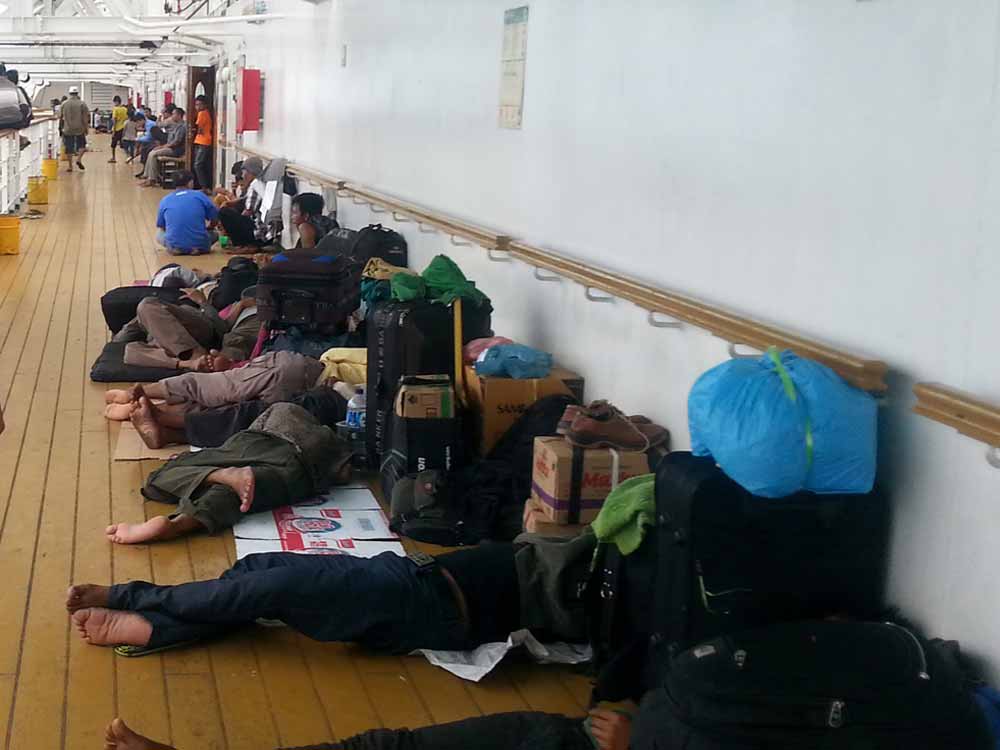
Economy latecomers claiming their little piece of floor space for the night.
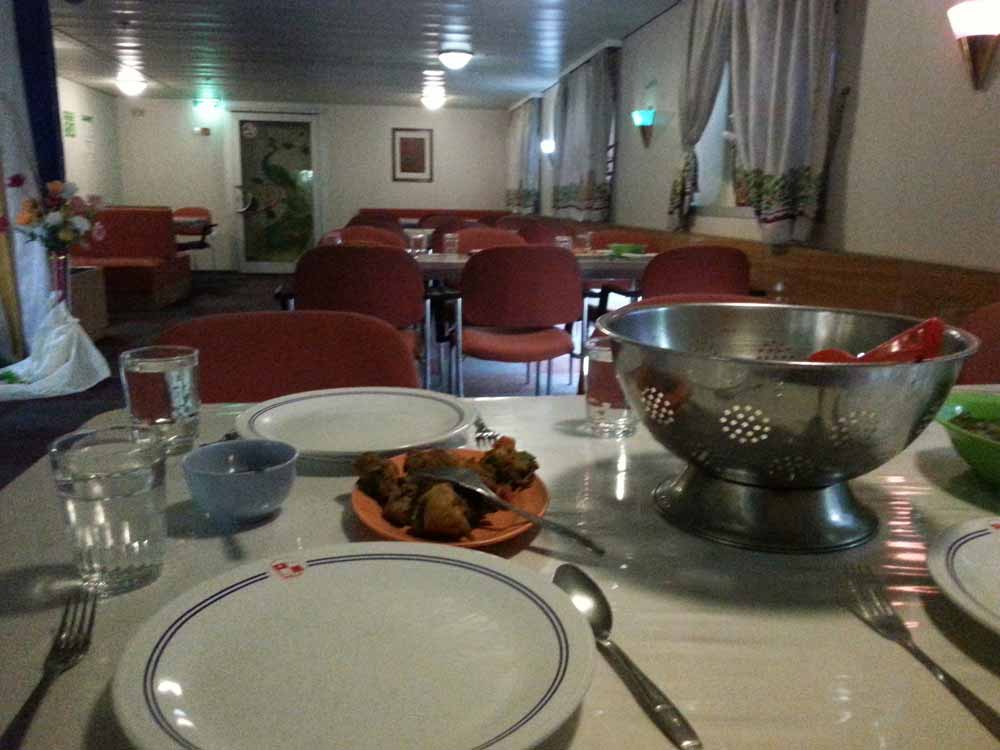
2nd and 1st class are fed at 6pm, usually fried fish, chicken, unidentifiable boiled vegetables and rice. On special occasions, a band made up of the pump mechanic, kitchen help, second level steward and captain’s niece in a D&G hijab and sparkly dress will pelt out 1970s Indonesian pop classics at full volume next to your table. For some things, there is mastercard – the good things in life are priceless.
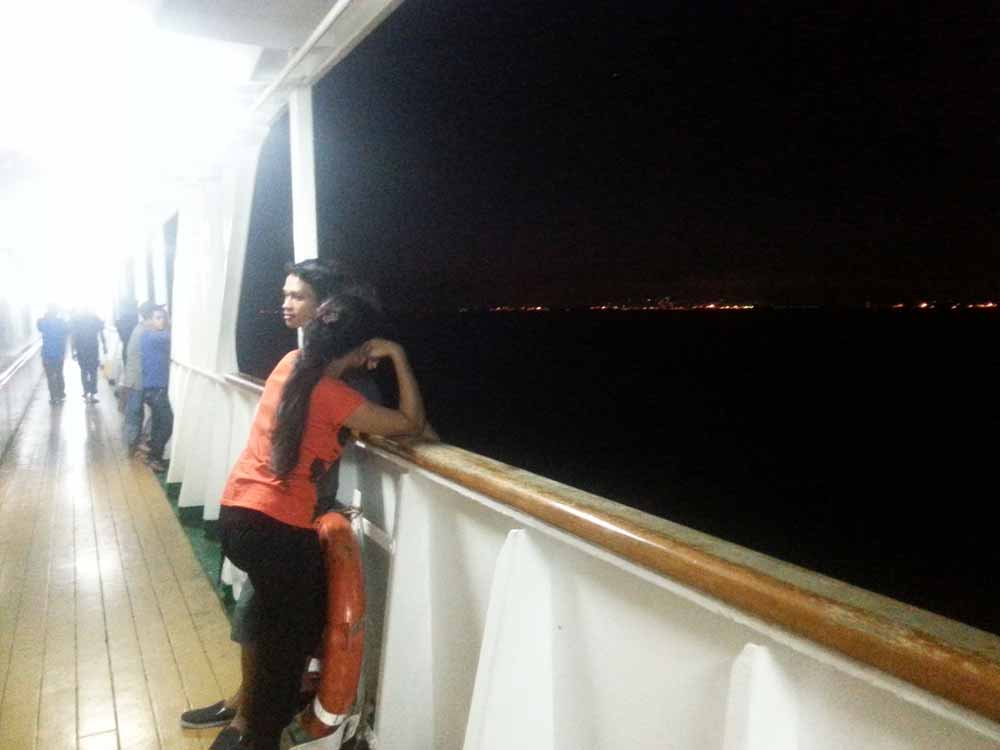
Finally at 1am, 8 hours after schedule and 16 hours after we got out tickets, the ferry left Sekupang and couples had the romantic opportunity to enjoy the view over Singapore’s multi-billion dollar lit architecture, from the comfort of their cardboard cushioned sleeping sarongs before bunkering down for a night of sea breeze on deck.
We arrived the following night at Tanjung Priok (see below) around 1am and called a Blue Bird taxi (24 hour service) to take us to our hostel in the centre of town (about 45 mins drive away. We wouldn’t recommend walking). Whenever you need a cab in Indonesia, call a blue bird. When calling, make sure to call the correct office – Jakarta: (021) 79171234/7941234, Bali: (0361) 701111, Lombok: (0370) 627000 etc. as Indo taxis aren’t amphibious (yet). They also have a smartphone app for easy booking in Indonesia.
Note that NOT all blue taxis are blue bird taxis. Taxis that are marked ‘blue group’ are also NOT blue bird taxis. There are countless stories of other cabs either making you pay ridiculous amounts of money, having no idea where they are going, arguing over already confirmed fees or putting people into seriously dodgy situations. Whilst we never had a bad experience with a cab, Blue Bird were the most reliable, easiest to deal with and friendliest drivers we met, and always put us on the meter.
Chill out in Jakarta for a desired period of time.
Jakarta to Bali: Train, Train, Train, Rickshaw, Ferry, Bus
1) Train Jakarta (Gambir Station) to Bandung, 3 hours, Executive Class: IDR 100’000 pp (IDR 130’000 pp through travel agent)
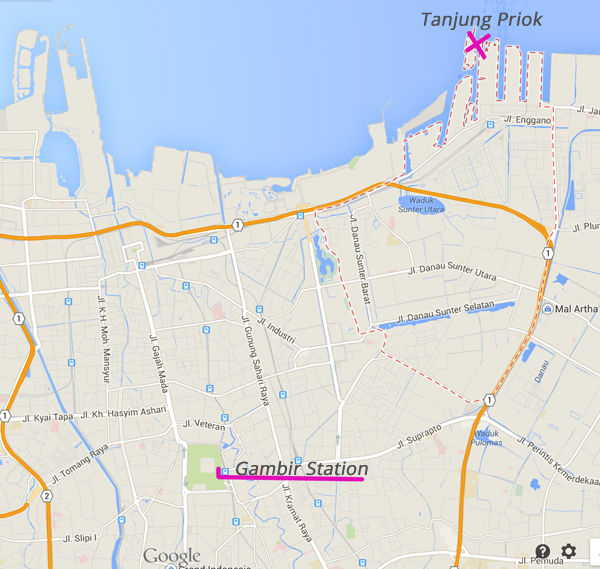
Transport from Jakarta to Denpasar (Bali) is usually a straightforward all-in-one ticket comprising a train to Surabaya and Bayuwangi, a ferry to Bali and bus to Denpasar. All sorts of very helpful info can be found on Seat 61.
We were unfortunately not quite as lucky as trains, busses and dodgy minivans were booked out days in advance upon our arrival, which had something to do with this holy time of the year for certain countries… oh, yes, Ramadan. If you find yourself in a pickle, worry not as a local travel agent who managed to work through his bosses completely illogical chatter and presented us with a solution – a similar route, but with more exciting stop offs. Read on and experience the wonders of the Indonesian rail network.
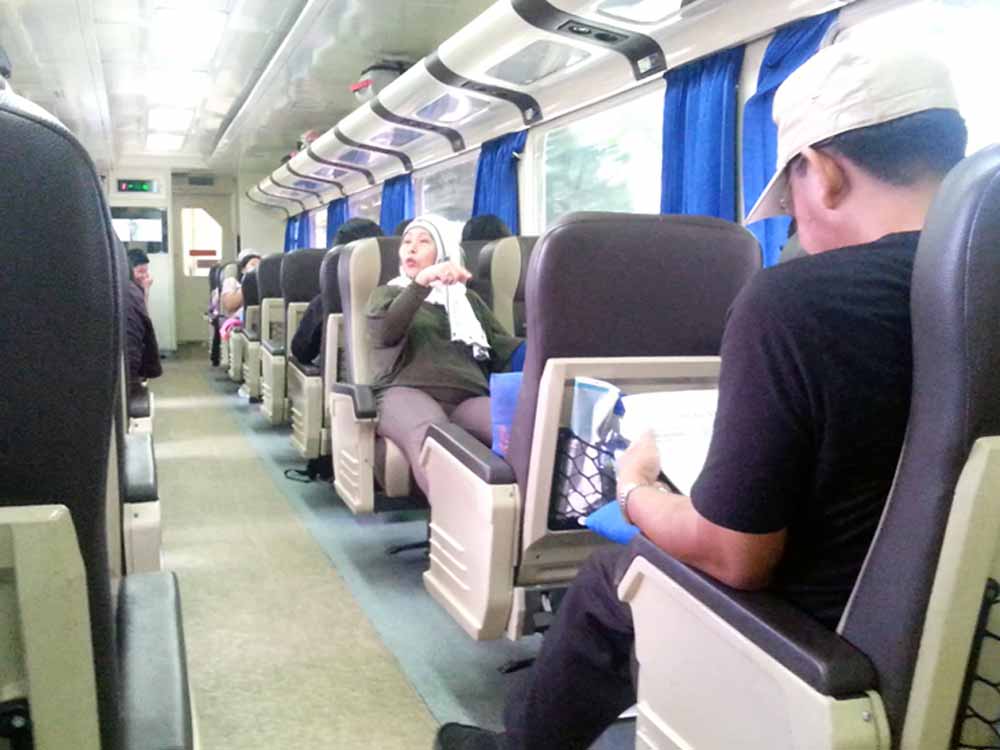
Board train at Gambir Station, headed for creative Javan hotspot Bandung. Note that the seats swivel like the Japanese Bullet Train models so you can face your new found friends or travel backwards if you’re into rowing.
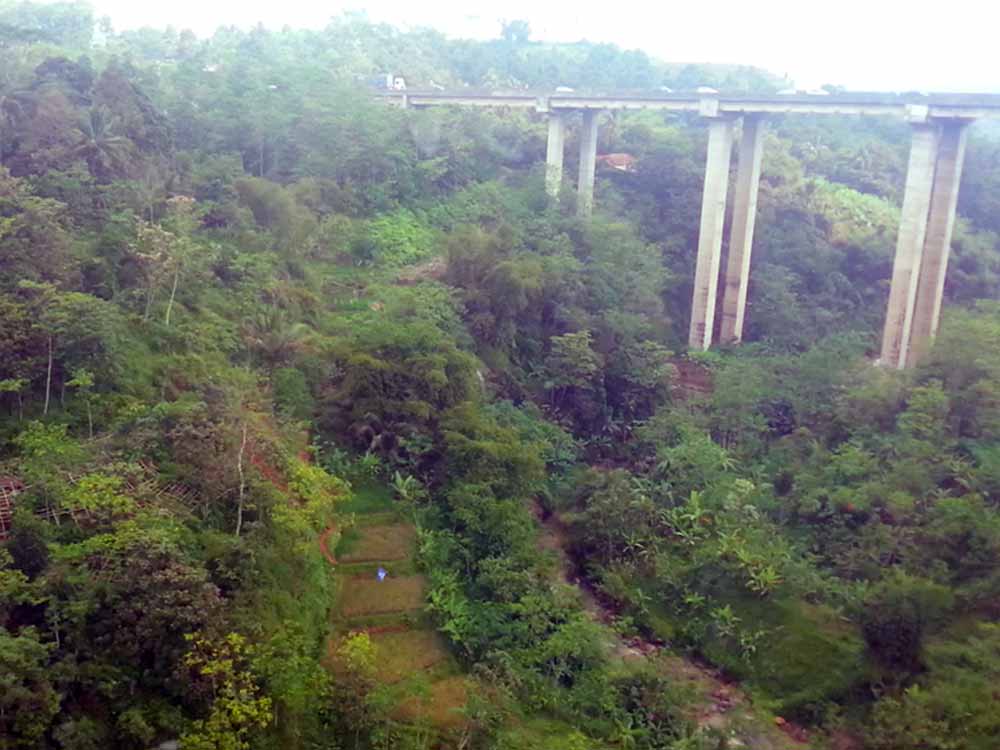
Enjoy the beautiful scenery along the way. Don’t drop your camera out of the window.
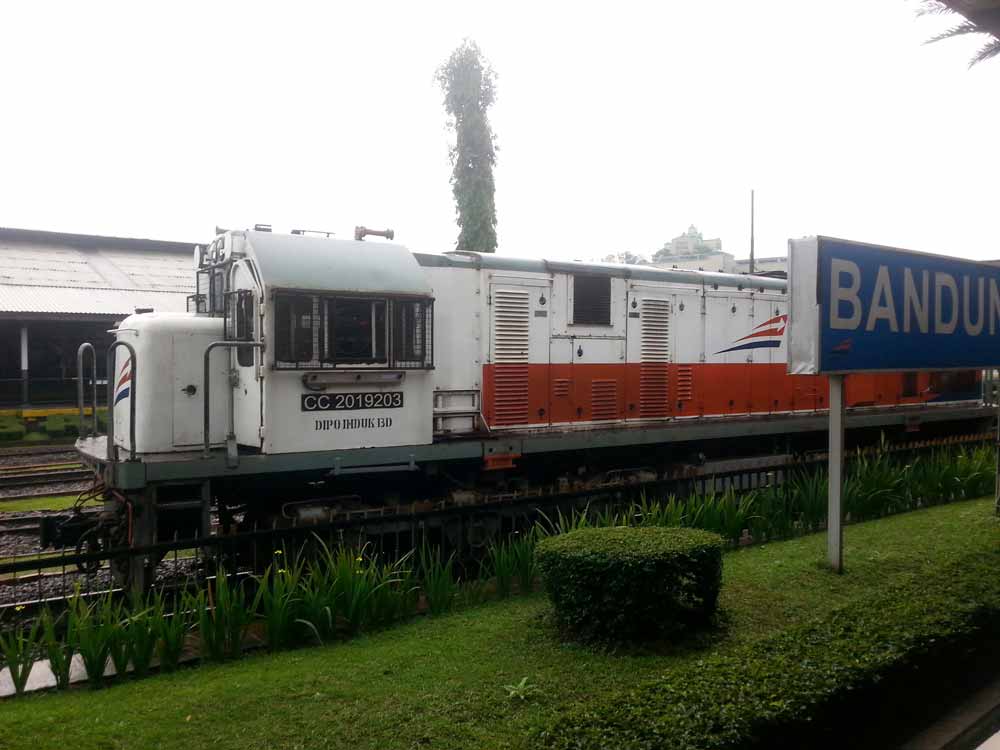
Upon arrival in Bandung, take lots of childish photos blocking out half of the welcome sign. Enjoy the really very good band playing for free in the passenger seating area. Go buy lunch at the japanese fast food place, walk back past the band and realise they’re all blind. Your mind may blow.
Go crazy in Bandung for a desired amount of time.
2) Train Bandung to Surabaya, 14 hours (overnight), Business Class: IDR 365’000 pp (IDR 395’000 pp through travel agent)
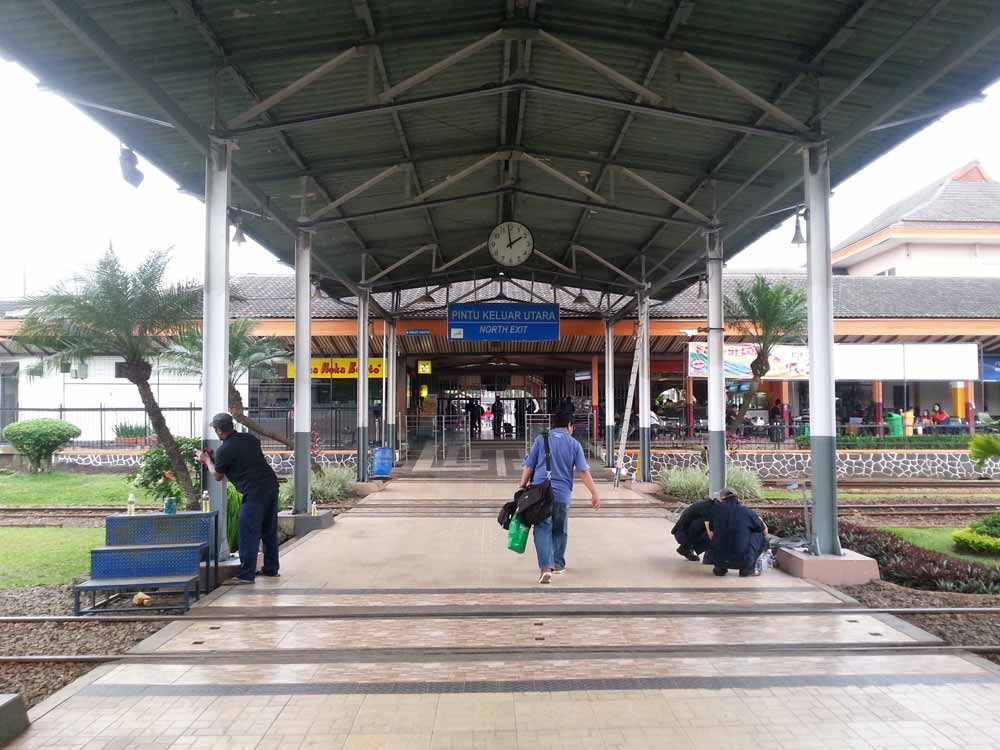
Once you’re ready to leave the trendy crowd of Bandung behind in search of your next exciting destination, head over to the tracks past the station’s immaculately kept gardens. Ask an attendant to point you towards your train as they sometimes park one in front of the other which makes it difficult to tell them apart.
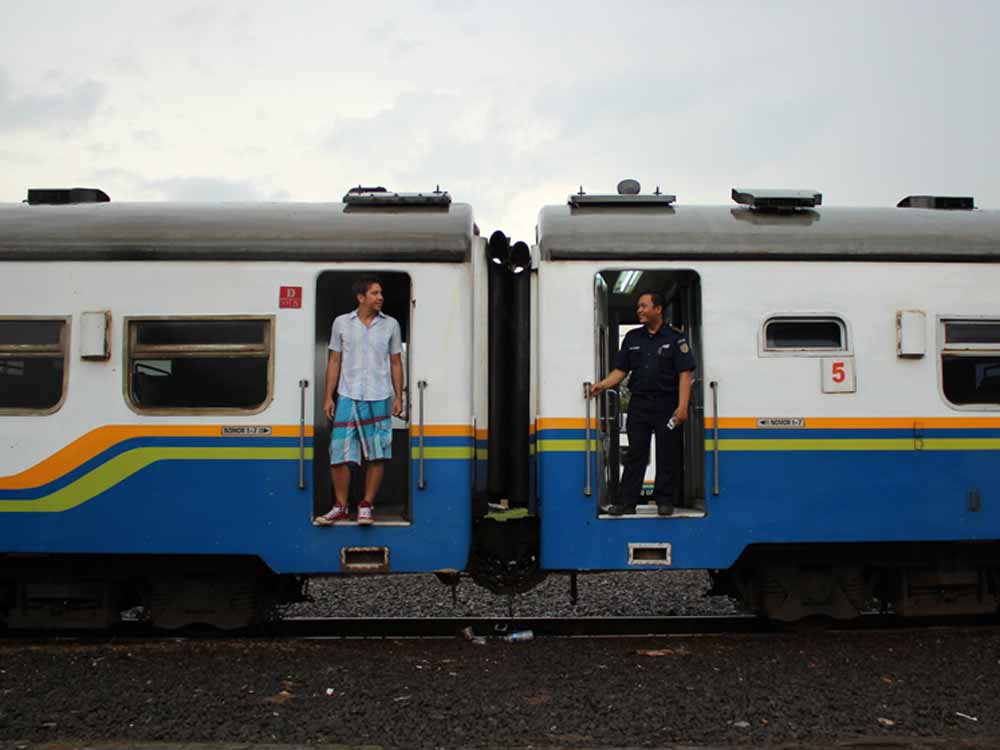
Walk way beyond the platform if need be, there will be wooden steps from time to time to help the less agile into their designated carriages. Do a Saxon in your carriage and chat with a conductor in a mutually made up sign language.
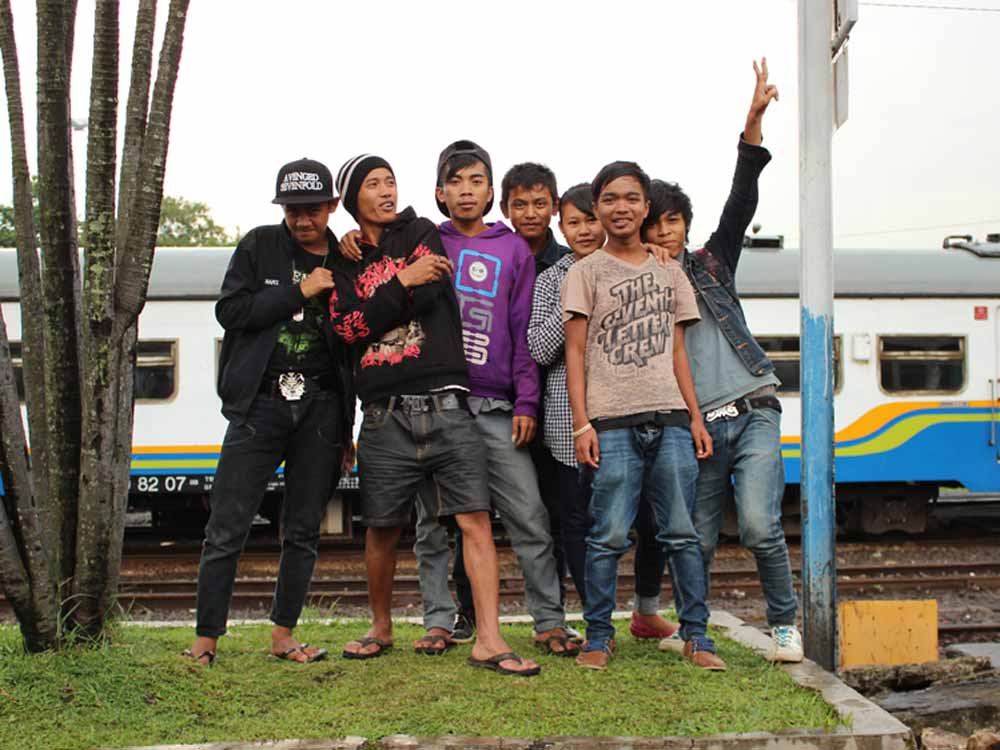
Local kids are also more than happy to pose for your camera. If you’re lucky you’ll see some of them train-surfing later.

Business class doesn’t have reclining seats, but we found the benches a lot easier to sleep on, provided you like the person next to you. Pillows are also provided, but collected early in the morning so get comfortable sooner rather than later.
3) Train Surabaya to Banyuwangi, 4 hours , Executive Class: IDR 255’000 pp combined train, ferry and bus ticket to Denpasar (IDR 285’000 pp through travel agent)
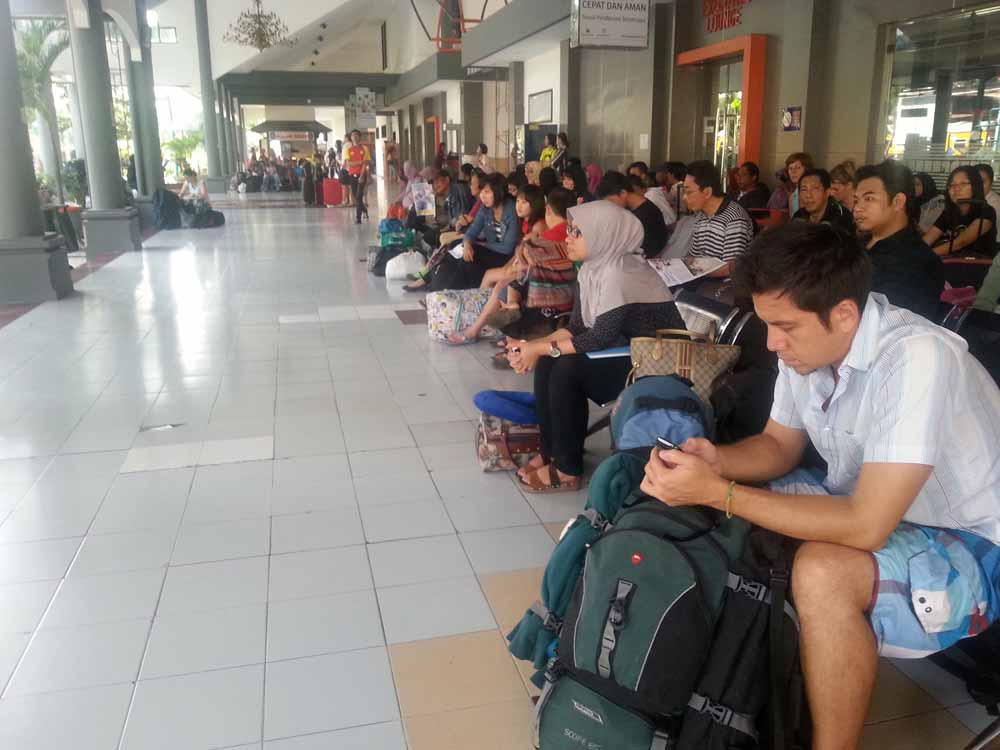
Get woken up way too early by the conductor taking your pillow. If you leave the waiting area or the Surabaya station, you are not allowed in again until an hour before your next train. If you do have to leave the station, there is a cafe confusingly called ‘VIP lounge’ in the main station building that is more comfortable than the floor. Alternatively, check out Surabaya’s statue of a shark fighting a croc in the city zoo. It might inspire you to chill for a while and postpone Bali plans.
Connected interesting fact of the day: Indonesia’s second largest city is locally believed to derive its name from ‘Suro’ (shark) and ‘Boyo’ (croc) who, according to myth fought for the title of strongest animal. The Aussies have a slightly more pragmatic take on the matter of animals, which you can read all about here.
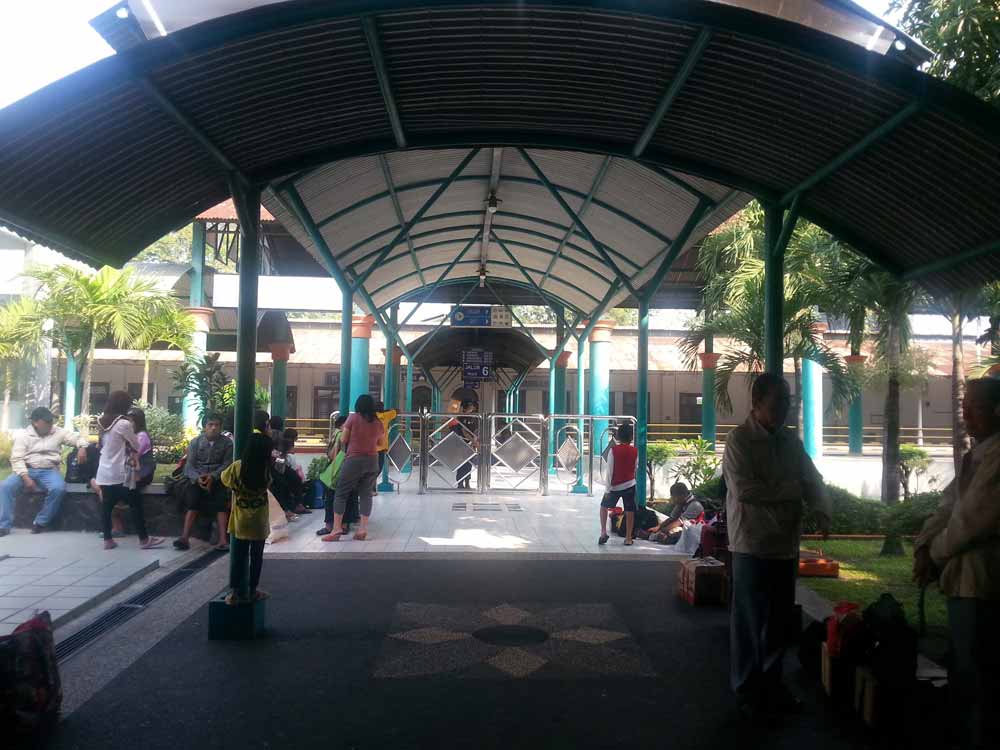
Be entertained by yet another X factor worthy head-scarfed girl-and-piano combo singing beautifully in the waiting area. When the train is ready, ask an attendant for confirmation (avoid heading with the flow, we nearly got sent back to Bandung by accident).
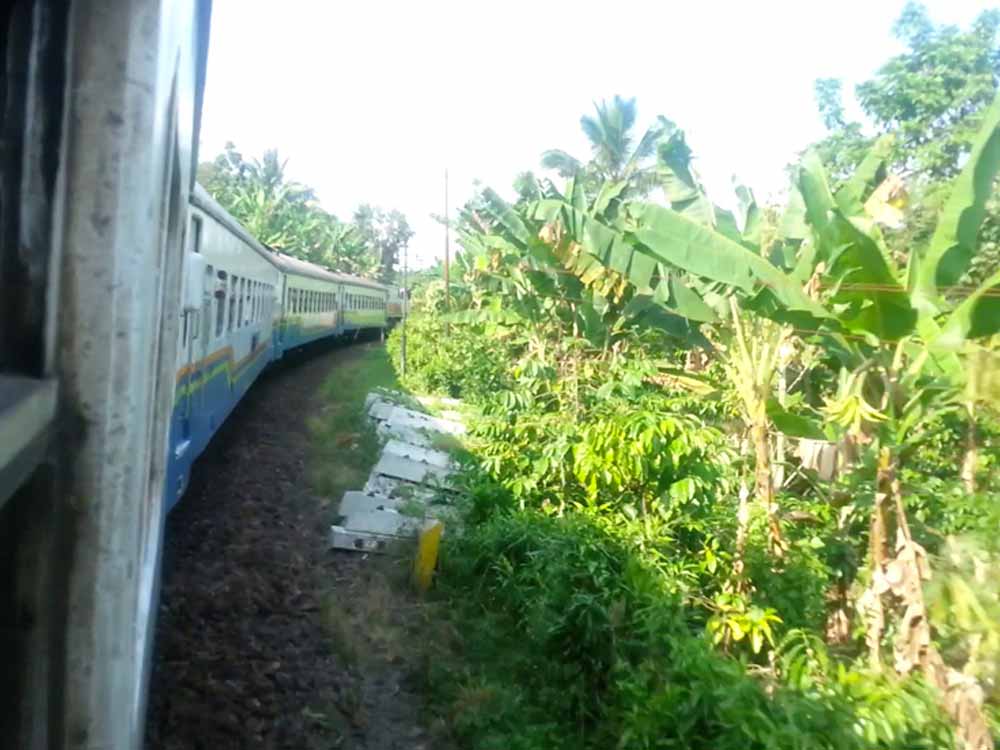
Seats are similar to the Executive Jakarta to Bandung service, but a lot more threadbare and lumpy. We missed our Business Bench, but the views on the way were fantastic.
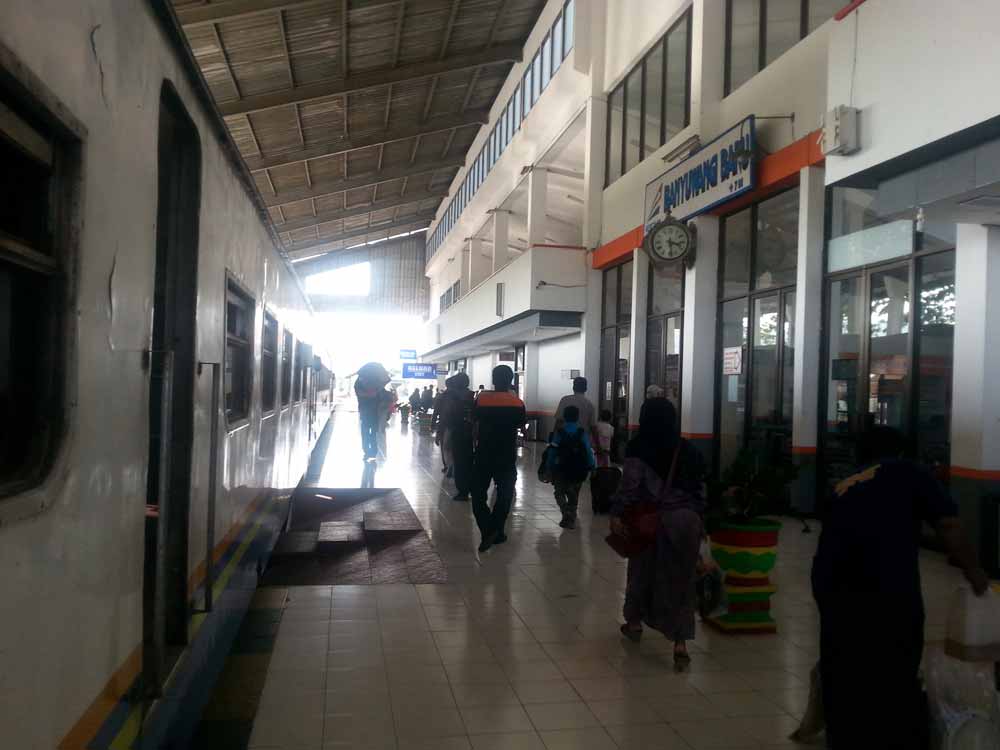
Arrive in Banyuwangi, everyone disappears. Get a bakso, get your ticket taken off you by some dude who tells you to wait for a rickshaw to the port. You have two options.
Option 1: Let loose in Banyuwangi (that already sounds like an awesome story). Option 2: read on.
4) Rickshaw from Banyuwangi train station to ferry port Ketapang, 10 minutes , included in price if you manage to avoid paying a large tip.
Photographic evidence of this thrilling rickshaw ride is far too blurry due to high-speed inter-lane highway travel. It was kind of like Star Wars Pod Racing. You’ll just have to use your imagination.
5) Ferry from Banyuwangi (Ketapang) to Bali (Gilimanuk), 1.5 hours, included in price if you track down the dude who is looking after your ticket for you.
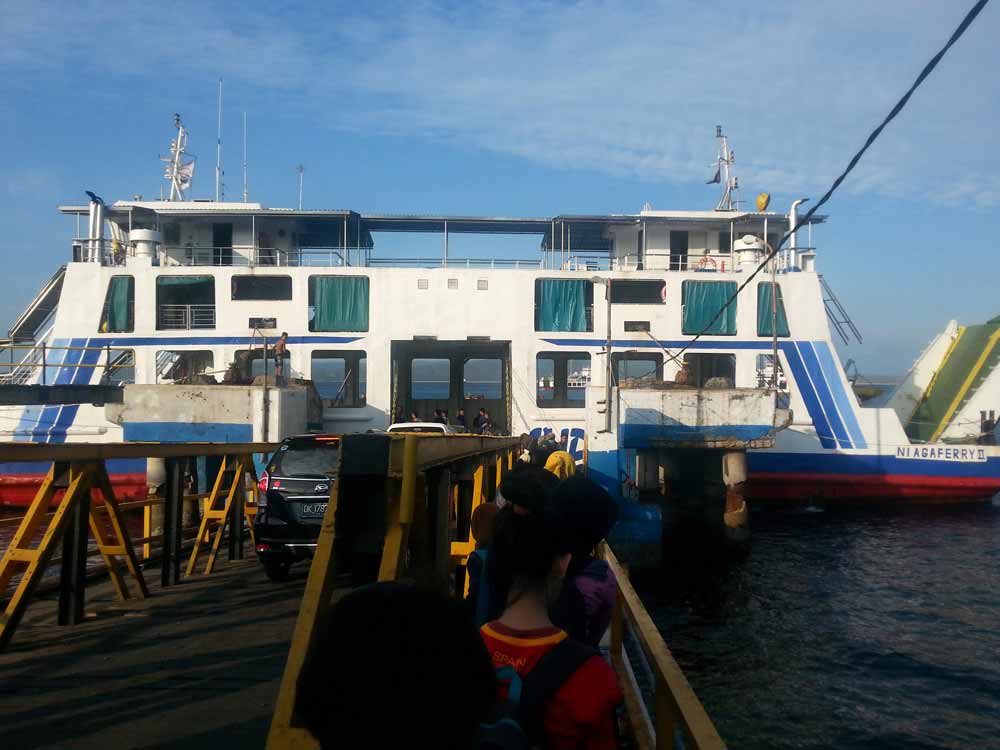
Ferries operate so regularly between Banyuwangi (Ketapang) and Bali (Gilimanuk) that a crossing that should take half an hour is so overloaded with operators that ferries have to wait in a queue for an additional hour before being able to dock at port. The crossing is over a very deep and open ocean like body of water, which means Bali is home to spectacular wildlife including Giant Manta Rays you can swim with at Nusa Lembongan. The crossing is sometimes a little rocky, but usually fine.
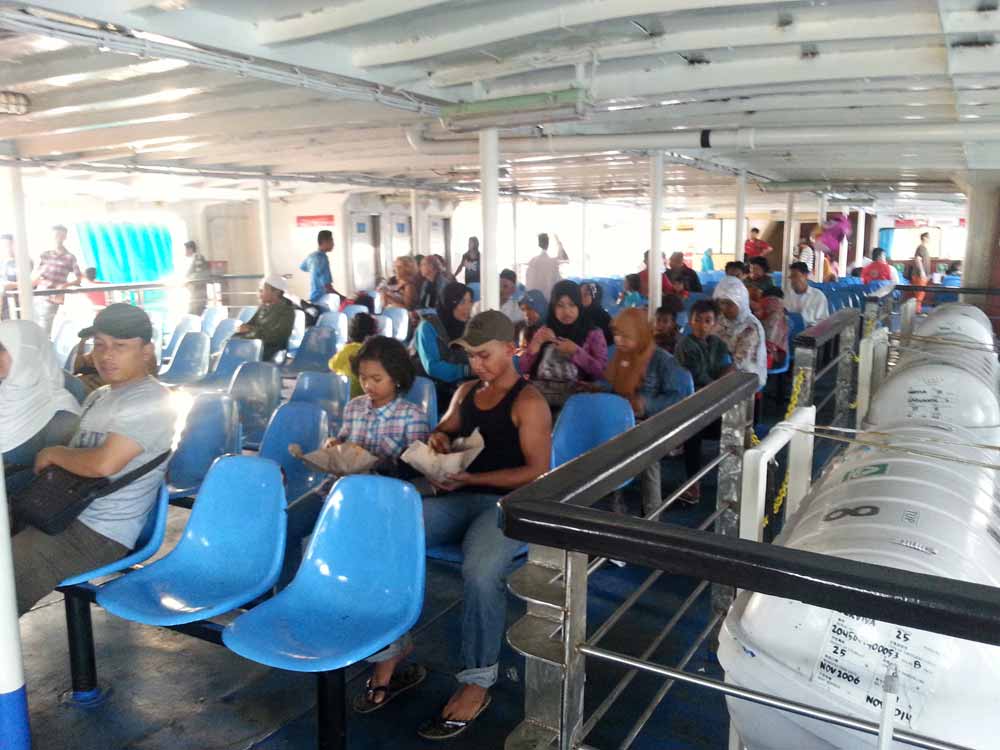
Some ferries have indoor areas, some, like ours, open deck seating where you can enjoy VHS tapes of trained monkeys on leashes doing tricks on a miniature bicycle to stupid music in exchange for booze. Cue an open mind and appreciation for unusual cultural differences. There is a little kiosk selling snacks – the home made potato fritters are fantastic.
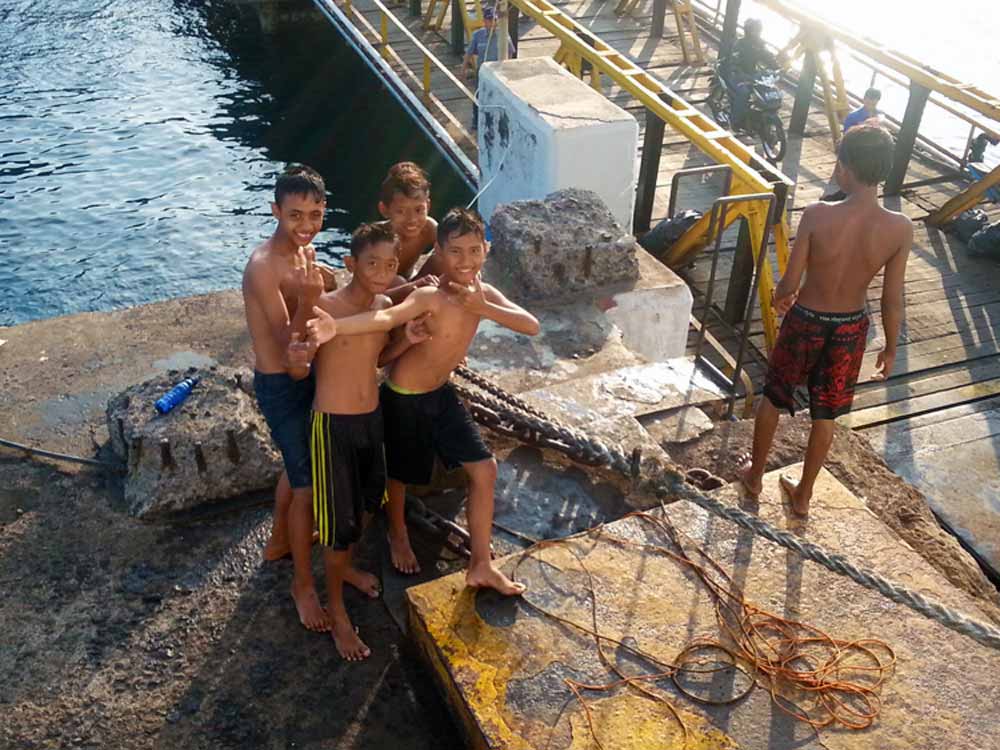
If you’d rather leave the entertainment up to local kids (and some daredevil grownups), these guys will jump in the water from very high and jagged places (including the top deck of the ferry) to catch coins thrown into the water by passengers who want to see the most spectacular jump. They swim back to the sometimes already moving boat, climb aboard and repeat. Raucous laughter included.
6) Bus from Bali (Gilimanuk) to Denpasar, 4 – 8 hours, included in price if you track down the dude who is hopefully still looking after your ticket for you and hasn’t buggered off to the pub/warung in stead.
So boring it didn’t even merrit a picture, the standard tourist minibus from the port to downtown Denpasar will take from 4 to 8 hours, depending on traffic and may stop off for dinner on the way (depending on the whims of the driver). When asked where we wanted to be dropped off, the driver pretended he knew anywhere else than tourist trap Kuta, which resulted in him driving us around the block three times and claiming it was upmarket tourist trap Seminyak. Thankfully our trusty Blue Bird taxi was with us 15 minutes after calling the Bali office on our SIMpati mobiles. WELCOME TO BALI!
We’re beyond interested to hear your stories from travelling through Indonesia, do share them in the comments. For the more eastward bound, don’t miss PART 2 of our Indonesia overland travel account: Bali to Timor.
All, Learn
Ever wanted a real filmmaking adventure? Exotic tropical travel, danger, beauty and glory? Well this could be your next project, but first, a word of warning: Rat & Dragon will not be responsible for injury, death or worse – kit damage – caused by attempting the following. (Although we’ll totally claim the credit for any epic surf footage you score). Read on and get inspired, and hell yeah – get out there and do it – but don’t say we didn’t warn you…
A small and beautiful island rises up from some of the deepest seas on earth. It’s a type of paradise, and it’s called Nusa Lembongan. It lies about halfway between the iconic islands of Bali and Lombok in the middle of the treacherous, whirling Lombok Strait. One particular beach on this island is fringed on its landward side by a small fishing and seaweed-farming village, and on its seaward side by a wide, coral reef lagoon. The outer edge of the reef is colourful, jagged and teaming with sea life, and it points into the direction of a sumptuous ground swell – oceanic waves that have travelled the surface of the Indian Ocean, uninterrupted, from as far away as Antarctica, before colliding with the Indonesian Archipelago.
Where this reef and this groundswell come together, something quite incredible happens. Wind direction, tide, swell and the shape and depth-profile of the reef conspire to create a powerful, hydrodynamic min-miracle – a near-perfect surf break – which barrels down the reef edge in flawless, fleeting slabs of hollow, crystal-clear Indian Ocean. Surfers call this type of mini-miracle a right hand reef break and named it Lacerations because that’s what happens when you surf it. The power of the waves as they thunder into the razor sharp coral simply shreds skin like grated cheese if you’re in the impact zone.
Aside from the danger in it, there is nothing short of unsurpassable beauty too. To a surfer, the scene is heaven – an opportunity to ride perfect waves, to feel like you’ve tuned into, and even mastered, the very nature of the universe itself inside a dynamic, hollow, seawater cavern as it rages around you.
To a filmmaker, it’s mind-blowing. There is sensational beauty in the motion of clear blue prisms as they contort into perfect forms. Tropical sunlight refracts inside, through and around ten thousand facets of seawater, in angles and directions that water can only exist in under tremendous forces, and never for more than a fraction of a millisecond, before it re-forms again and explodes. Add a surfer riding these perfect forms in sublime synchronicity, and surf filmmaking becomes a type of performance art of the highest order.
Filming surfers at Lacerations can be done in one of two ways. The safe option is from a pontoon anchored in the channel beside the breaking waves. You’ll need a boat to get yourself and your gear here, as it’s about 500m from the shore. Locals will take you on an outrigger for a dollar. Stash your kit in a quality dry bag and bring a dry towel. A zoom lens at 200mm and higher is a requirement for tight shots from this angle, and naturally a tripod or steadycam. The pontoon itself will of course be moving so keep this in mind.
The position of the pontoon is perfect for viewing right down the line – surfers will be riding directly towards you as the wave curls perfectly behind them, or closes around them completely. It’s like looking down the barrel, quite literally (a hollow wave is called a barrel – riding inside the hollow wave is “getting barrelled”). From here, on a clear day, Mt Agung, a massive volcano on neighbouring Bali, entirely dominates the skyline behind the action. It’s poetry of composition.
By far the most dynamic and engaging way of capturing surfers at Lacerations, however, is to get wet and swim out into the action. DO NOT ATTEMPT THIS UNLESS YOU ARE AN EXPERIENCED SURFER YOURSELF. As well as surf techniques, surfing “rules” and physical abilities surfers are likely to know or have, surf waves have readable predictability IF you know what you’re looking at. There are safe zones, currents, sections and rips that can keep you in the clear. Likewise, there are places you just never want to be caught in. Ever. So assuming you’re a surfer excited about shooting Lacerations, or you’re a strong, confident swimmer who plays by your own rules regardless of what any crazy Rat & Dragon says, or if you’re just keen to hear how we pulled this off, please read on.
You’ll obviously need a camera with waterproof housing. We simply used a GoPro on a “selfie” pole. Set to 60fps, 1080p, you can slow the action right down to get incredible images of tumbling, exploding, vertical and over-vertical water. For us, the real magic on screen came from filming from within the wave itself. Showing a fish’s-eye view of the surfer, crouched and speeding through a raging tunnel of water (getting barrelled) from inside the wave. The surfer is slotted inside a tube of crystal seawater, as if in command of his own twisted air bubble under the sea.
Shooting with a wide lens for optimum dynamic feel, you need to get as close as possible to the surfers. There’s countless inherent risks in this – not least that the surfer is moving at great speed on a sharp, pointy piece of fibreglass with sharpened, rigid fins on the back. He or she is also going to be at the most powerful part of the wave, only a split second or so away from the moment that part of the wave pitches over and smashes into the shallow, razor-sharp coral below.
To get in this position, you need to be just outside of the impact zone and directly down the line from the surfer’s take off point. There will be steady currents dragging you into the impact zone so you need to keep constantly swimming outwards. As a surfer approaches, hold your ground with camera rolling until the wave’s lip is almost pitching out over you. Dive down into the wave (duck dive) but keep the camera pointed at the surfer. The pole will allow the camera to be in position longer than you are safely able to be.
Another word of warning on this – the water at Lacerations can be extremely shallow. Be careful not to dive too deep and hit the coral. On the other hand, don’t dive too shallow and risk being hit by the surfer. There’s an extraordinarily thin line between the two, and even with the years of surfing, freediving and ocean living experience that we have, chance probably still played as much a part in the Rat & Dragon crew not getting injured as positioning and technique at these critical moments. Remember, even when completely submerged, keep the camera panning on the surfer for as long as you’re able. The water at Nusa Lembongan is often so dazzlingly clear that you can film the surfer riding off into the distance through the wave as it passes over you.
Lastly, a word on your subjects – surfers. For this project, the Rat & Dragon crew had a team of talented athletes from Mojo Surf, Australia’s biggest surf school and surf experience providers. Not only were they willing subjects, but they were positively excited about getting into frame and show surfing in it’s greatest light.
Having your own willing team of surfers to shoot is the only way to do it. An unknown videographer flailing about in the surf will be less than welcome or even actively discouraged by surfers in the line-up. You could become an annoyance or even a danger to the surfers (or yourself) if you’re in the wrong spot. And surfers you’ve never met – like anyone – may not appreciate having a camera in their faces while they’re getting about their own business. If you don’t have a team yet, don’t let that stop you. Once you’re on location, get talking to groups of surfers on land and see if any are keen to have some images of themselves. You’ll more than likely find some willing subjects. Just make sure you have a solid rapport first. Everyone’s enjoyment, and maybe even safety, depends on it.
Being the Rat & Dragon’s first surf assignment, we were really lucky to score good-sized waves and incredible water and light conditions with some really cool crew. Nusa Lembongan’s Lacerations is such a cool surf break to shoot in stunning location and we managed to get away with only minor coral scratches as the price to pay for some for awesome video content. Get there now, have fun, but play safe. If you’ve shot or are planning to shoot at Nusa Lembongan, please get in touch with us!
And if you’re curious to see what it all looks like, check out MojoSurf Bali & Beyond wrapped into a wonderful 2 minute package:

All, Inspire
How’s it going? Everything smelling as it should? Nice to sniff your behind, run around the block and get to know you a bit, you seem like a pretty cool bunch of people. Do you like my picture? I made it myself on Photopup.
If you’ve ever been to Bali or Java, you’ll know me. If you haven’t, my name is Zero, and I’m kind of a big deal around here. These days I hang out mostly around Red Island, an awesome beach on South-East Java, with my mates Ari, Mul and Mick. We have a pretty sweet pad going on – pool and all. It has this awesome red sign (at least I’m told it’s red, I’m also told dogs are colour blind, but I don’t believe that part), and it’s got eyes and squiggly lines on it. It looks something like this: M OJ O.
It wasn’t always the high life though. I’ve had my rough and tumble. I’m 3 years old now which is quite good going in my neighbourhood. And don’t look too bad for it though, I check my reflection regularly in the river outside our pad on the way to the beach every morning. Gotta look good for my patrol.
I am what people would describe as an ex-athlete. Maybe a boxer in human terms, although I’d say my experience is more in the MMA field. I was born on a beach on Bali, I can remember seeing the sea for the first time and thinking – WOW what an amazingly large puddle. Then I went in and realized it was all salty, so I didn’t do that again. I’m not a pussy though, it was cause the salt blurred my vision and I needed to be ship sharp.
When I was a young pup, I met these three guys called Mick, Ari and Mul. They came to my restaurant and we hit it off instantaneously. They told me stories of the bright lights of the city, and being young, dumb and full of beans I was intrigued. I couldn’t stop thinking about the excitement of the cosmopolitan lifestyle, so when two hours later they said I should tag along, all three of us headed towards Kuta.
Mul, Ari and Mick are the best. Before I was born, Ari left his village in Red Island to go to university on Bali. From what I understand, a university is a big house full of books and no food, so I don’t really concern myself too much with these things. Ari didn’t have any money, so he slept with my great grandparents under the stars for a few months whilst going to the book house every day. He came out at the end with a piece of paper and a big smile and said he was going to change everyone’s life. “What a dude”, granddad said he’d thought at the time.
He then met Mul and Mick and they set up a shop together in Kuta, which is where we went together. A shop is basically like a university, but with less books, more food and more smelly people. I loved it. I got in with a bit of a rough crowd but they taught me how to fight. And if you can’t fight on Kuta’s streets, you’re out. You basically have to pack your things and move to Seminyak. And no dog wants to do that.
The boys were a slight concern though. Humans can’t fight like dogs, they don’t know the etiquette, they don’t respect the hierarchy of things. Some tiny idiot in a big tin can that says ‘Porsche’ thinks he’s the shit, and some big guy drinks too much of that smelly stuff with the red star on the bottle and thinks he can take someone’s hat without asking. Humans are idiots sometimes, and I know Kuta inside out.
Naturally it was my job to make sure the boys were safe. They are awesome of course, but it’s the other humans you need to worry about. I made sure they were ok though, when they went clubbing I arranged with the manager before so I could go with them. If they took their scooters for a late night snack, I’d be at Macky D’s to make sure they got all the food they ordered, and that no one took any whilst their backs were turned.
They paid me back loads though – Mick even got into a fight once cause this idiot kicked me and Mick stood up for me. And when one day I got into a bit of a furry situation (think Butch in Pulp Fiction – I just have too much integrity to take bribes), Mul and Ari saved my life by smoke bombing with me one night.
Red Island is now my home. When Mick first got here, he was so stunned by the waves he slept under a Pandanas Tree for a week, just to be close to the water. Don’t get me wrong, it wasn’t like there was a house to sleep in anyway, but I’m told that this certain type of human has a tendency to stay close to water they like. They also often carry around a large piece of white plastic, a bit like a door, with a little string on the end. You may not believe me (and I don’t blame you), but I have it on good authority that the string is tied to the human’s leg so the door thing doesn’t get washed away in the waves, cause… wait for it… the humans stand on the door in the waves! Crazy, I know. I think they call it ‘smurfing’.
After the boys got a little bit tired of living under a tree (those mosquitoes are ok if you have fur but if you’re a naked human monkey, they get annoying) they dug out Ari’s piece of paper from university that I heard had something like ‘Degree’ and ‘Tourism Management’ written on it somewhere. “Why is this relevant”, you may ask? I know – after all I can eat a piece of paper in less than 20 seconds. But apparently the paper means Ari has the authority to tell people about a place and bring them there on holiday. So the boys had many meetings with Ari’s friends and family, and everyone else living in the area – all of whom where keen to invite people to come to Red Island.
Ari, Mul and Mick started talking to the government and saved up money to buy a piece of land by the beach. I of course made sure it was all kosher and soon enough they were building small houses with beds so other people could stay in them at the weekend. There was quite a bit of plastic on the beach when we arrived – for me of course a total non-issue as plastic usually contains tasty leftovers. But apparently it’s not so good for the sea and the other animals, so the boys teamed up with the elders and explained it to everyone living there.
Beforehand, no one really cared (except the other dogs, who wanted more plastic as it means more exciting leftovers – no brainer if you ask me), but now they were doing the whole tourism thing, it was good to get everyone to clear up, and to get the government to send round some humans once a week with a big smelly car to collect all the plastic. The boys organized a day when everyone came to the beach and cleaned it up – there were old humans and middle-aged humans and a whole bunch of school humans too.
And that made me think about it – I get food from the boys, and the amazing mix of smells from the smelly car totally make up for the lack of leftovers. It’s so good I even bark thank you at it sometimes. I have my pension; I have my patrol route and make sure no one steps out of line in the area. You can pee on the gateposts, but if you even think about pooping in the pool, you’ll have me to reckon with. Everyone knows that. And our pool is brand-new and the first one in the region, so we’re all very proud of it.
The boys do their smurfing thing and bring other smurfers to Red Island. Some of them are pretty good; I saw one jump out of the end of a wave on one of their doors the other day. It was awesome. Others are not as good (you can tell cause their doors are big and red, with the eyes and squiggly bits on, just like our sign), but they seem to be having loads of fun whilst I make sure they’re safe and don’t poop in the pool.
There’s a group of people digging a huge hole into one of the mountains nearby – and it’s not for hiding stuff, but for pulling this yellow stuff out. I saw this musician called Jay-z on TV, you may have heard of him, although he’s not nearly as well known as I am. He was wearing it around his neck, think it’s called gold. The hole-diggers want to use lots of chemical things, but because of Ari’s tourism idea the humans here know they need to keep the water clean, so are telling the government to not allow the hole diggers to use chemical things.
This tourism thing of Ari’s has been a pretty smart idea, people come to Red Island now just for fun, and to eat in the restaurants, so people here can earn money (and we get the leftovers). And this means they look after it more and more, so more people will come. It’s quite a party – but they’re also making sure it doesn’t grow too much, so I can keep the overview.
So, as you’re a pretty cool crowd, and I love you already, you should come and see us some day. I’ll be here, Mul, Ari and Mick will be, and M OJ O and some other smurfers too. Ask for Red Island – or if you’re talking to a local, just say Pula Merah (see, I’m even teaching you some Indonesian!). Or you can ask these Rat & Dragon guys who are publishing me on their blog if you have one of those metal Wifi box things humans watch videos of cats embarrassing themselves on (big fan of those!). I hear we’re pretty shit hot, we don’t even have tin cans with ‘Porsche’ written on them, just a big clean beach and a pool and lots of doors to stand on in the waves.
** Note from the editor: several spelling mistakes corrected and ‘woof’ noises omitted. For visual record of Red Island, please see DAY 7 of Mojosurf Bali & Beyond or the corresponding hero film:

All, Destinations
“It’s gonna be outrageous!” says Nat, the founder of Mojo Surf, “It’s a three-week Bali & Beyond surf tour through four Indonesian islands, squeezed down into just eight days.”
“OK…” says Rat & Dragon. “We’re interested…”
Nat goes on: “Surfing epic tropical breaks, searching jungles for more epic surf locations, boats, planes, jeeps, boards, bars, beers, babes, dudes, random free dives, cliff jumps, pranks etc…”
“Hell yeah!” We say
“…and we want to take this to the world, daily” Says Nat.
Our bags are already packed before we can even say “Deal”. But what would taking it to the world daily come to mean? Nat promises “outrage”. Could Mojo Surf deliver? If they do, how are we going to capture it? And even if we do shoot all this awesomeness, what would it take to back it all up and edit it daily…? As with surfing, there’s no room for hesitation. Rat & Dragon paddle for it, claim the wave and ride it – wherever it was about to takes us…
First stop is the brand new Mojo Surf lair in Canggu, Bali. An awesome little villa just a couple minutes by motorbike (with surfboard side-car) through rice terraces to a selection of quality surf breaks. We meet the Mojo Surf team, a fun-obsessed crew of 11 shredding surfers and brand new beginners, all frothing to get in the water to kickstart their Indo adventure. A traditional Balinese gamelan (bamboo instrument) performance and blessing ceremony is followed by an epic barbeque and the inevitable pool party. You can get a flavour for it here.
What follows is just as Nat described it. Outrageous.
Day 2 starts way too early with ice-cold coconut hangover cures and a dawn yoga session, followed by a solid overhead surf at a break called “Old Man’s”. We load up vans, transfer to a boat and blast across the Lombok straight – among the deepest stretches of water in the world – to Nusa Lembongan – possibly the coolest island of the 17,000 in the Indonesian archipelago. There we dip in the pool, do some “skurfing” (waterskiing behind a boat on a surfboard instead of skis) and then a sensational purple sunset surf under the volcano at a right hand reef break called “Lacerations”.
Day 3 starts at dawn again. A quick boat trip across ludicrously clear, deep water to a cliff-side freediving spot and we’re suddenly swimming with giant manta rays. A dream-come-true.
And yes, we filmed the shit out of it. Check out our Manta Place Cake:

After that magic encounter, it’s back to shore for Theresa’s very first surf lesson. A quick run-down and some pop-up practice on a lawn surrounded by hibiscus flowers then into the water at a beginner friendly reef break. Theresa is off, surfing the very first waves of her life. You can see the stoke on her face, and the blossoming of a brand new lifelong addiction. If you’re a surfer, you will know this feeling. (If you don’t know it yet, what are you waiting for? Contact us for how to get started!)
The other experienced guys are back at “Lacerations” getting barrelled. Rat & Dragon are in the water there too, paddling a fine line between filming and surviving. Survive we do, nailing shot after shot of incredible surf footage that might just knock your socks off. Read about that epic surf and film session here. That night there’s another pool party…
Day 4 has a gentle start because the tide isn’t right for surfing. We eventually get on a new boat bound for Lombok. The ride is smooth, and the boat becomes Rat & Dragon’s film studio as we edit out some of the coolest content we’ve ever captured. The boat docs and we load up a couple of vans and explore South Lombok before we find another right hand reef break, just on sunset. It’s gold in the sky and it’s reflected back in motion off the surface of the sea. It’s just us. The camera is rolling and Rat & Dragon are in love with Lombok.
Day 5 is another dawn mission by van through the jungle, past water buffalo, to the tiny fishing village of Garupuk. We negotiate passage out to a left-hand reef break with some fisherman aboard two bamboo outriggers. The break isn’t ideal for the wind and swell, so we cruise across the bay to the opposite headland and surf a matching right-hander, on our own, below massive yellow cliffs.
When we’re back at our base in Kuta Lombok that afternoon, Rat & Dragon get stuck into our footage while the other guys get on with organising another party. Somehow, spontaneously, in a dusty, gorgeous, one-horse town, they arrange DJ decks, speakers, lights and about 200 young, adventurous revellers to dance and drink and party.
Day 6 starts thankfully late. We load up vans again and head to the airport, but manage a detour via a vast, stunning, white-sand beach, who’s name no-one seems to know. The waves are perfect for our beginners so an impromptu lesson on the sand precedes an epic experience. Theresa and Fanny, surfing the same crystal clear waves all the way to the beach, and re-affirming their new love of surfing.
We board the plane still salty and can see the surf breaks of Lombok below as we skim through the cloud-studded sky before landing back in Bali. The next stage is an overnight van ride and ferry crossing. We shuffle into grass huts in some secret location in East Java in the dead of night, disoriented and weary, but what we wake up to the next day makes it totally worth it.
It’s Day 7 and we’re woken by roosters. Peering out of our huts and blinking into the daylight at Red Island for the first time, we’re amazed. It’s a tiny village with nothing but a narrow dirt lane. Shafts of dusty orange dawn sun stream into a tiny glade of tall slender trees and light up the tiny bamboo warungs (shop/restaurant) hidden inside. On the other side of that we see the perfection of a vast, unknown, jungle-fringed Java beach. Just off the shore, chest-high waves peel left and right, with no-one at all out there to ride them. No-one but us, that is.
After as many surfs as we want, the locals put on a special evening event for us. Grilled fish that were alive that morning taste sensational. The beers are cold. The bonfire on the beach is sumptuousness itself for the eye and the camera lens under the starry, moonless sky. As the other guys went to bed, the temptation for the Rat & Dragon crew was too much not to film a time laps of the incredible stars, streaking through the sky as the earth spun beneath them.
Day 8 arrives and it’s almost all over. A quick morning surf and the cars are loaded for the journey back to Bali and the Mojo villa. It takes ages so we don’t get to scout any new beaches on the way back as we’d hoped. But that gives us the chance to ply through our footage again and assemble more films. This time the Rat & Dragon studio looks like a van full of surfers with boards on top.
When we eventually reach the villa, we’re not there long before we decide to celebrate the adventure with a session at a nearby night spot. Deus Ex Machina is a store selling customised motorbikes, longboards and original surf artwork during the day, and at night it becomes and meandering restaurant and bar with live music, DJs and skate halfpipe.
We’re all there on the dancefloor, surrounded by new friends and good tunes. Cold beers are raised to the adventure, to the destinations, the waves, the killer content and the personal triumphs and near-calamaties. We toast to the people we’d met. The words epic, awesome and even outrageous fit the Bali & Beyond project perfectly.
If you can’t wait to see what it all looks like, we proudly present Mojosurf Bali & Beyond, packed into 2 minutes of awesomeness to knock your socks off:

All, Learn
Many hate him. His armour is so hard and sharp and that he easily punctures and tears through flesh. He lives in trees, and is so heavy that he can cause enormous damage – even death – if he lands on you from above.
So reviled that he is widely banned from hotels and public transport, it’s also totally illegal to bring him onto an aeroplane.
He is the durian, and he’s the monster of the fruit world.
Growing up to 30cm long and weighing up to 4kg, it’s not his bulk, nor his skin-shredding rind that makes him an outlaw.
It’s his offensive, all-permeating stench that, even unpeeled and sealed in plastic bags, can still poison the atmosphere around him. The smell is like cheese and sardines wrapped up in dads’ football socks, and it can waft down the street, around the block and punch you in the nostrils as you laze innocently in your guesthouse.
So what the hell do people grow him for?
Well, if the durian is the monster of the fruit world, he’s something of a Dr Jekyll and Mr Hyde.
You see, like Jekyll and Hyde were both sides of the same character, so the durian has two personalities. While looking and smelling like a monster, he is widely known as the King of Fruit, for the reason that (as many claim), if you can get through the intensity of stench, underneath the spiked armour, deep inside his hard shell lies the single greatest-tasting fruit flesh of the natural world.
King or monster? Rat & Dragon investigate.
Clinging to a steep mountainside and surrounded by rainforest and lush stinky orchards, Mr Sheng built a small durian-tasting balcony with magnificent views over the national park, and beyond that, the sea, somewhere between Batu Ferringi and Balik Pulau on Penang’s northern corner.
Guided there by our local buddy, Eddy (owner of the awesome Pit Stop Cafes in the world heritage lanes of George Town), Mr Sheng introduces us to the mysterious green spiked monster.
“First, to select your durian, pick him up carefully and shake him. If he rattles inside, he’s too old and dry” he demonstrates. “My durian are not picked, but fall naturally from the tree when they are ready, ensuring they are the freshest and most flavoursome they can be. These all fell today.” he says as he points to a massive pile of beast-like fruit on the concrete floor.
Satisfied with his own choice, Mr Sheng pulls out a special curved blade and explains how to slice through the durian to extract the 5 flabby, fleshy segments inside.
“The flesh closest to the stalk is the most intense,” he explains. “It receives the tree’s nutrients first.”
With deft, spike-proof hands, the years of his durian experience showed in the skill and ease with which he splits the monstrous fruit to reveal enormous cream-coloured segments that look like massive, eyeless grubs, about the size and shape of a healthy man’s poo.
The smell. Somehow we’d gotten used to it and it didn’t seem offensive anymore. We were, after all, enveloped in a pungent cloud of durian reek. Nevertheless, it still hardly looked like food at all, let alone appetising.
Tentatively, we took hold of a chunk. Its consistency was that of melted cheese. We were warned about a large, polished seed inside. We had to suck the creamy flesh off it (insert innuendo here). We were instructed that the more vigorously we sucked (tee hee), the more air we would draw in with the mouthful, and so the more flavoursome we would find it.
Hesitate.
Grimace.
Sluuuuuuuuurp.
To a great deal of surprise, relief, and furthermore, positive delight, the durian tasted sensational. Utterly unlike any known fruit or vegetable. In fact, utterly unlike anything either of us had tasted.
To describe it we used words like chardonnay, crisp bacon trimmings, pâté and vanilla custard. Faintest echoes of fresh mint and caramel latte vie with salty umami. All of those words and yet none of them at all worked to pin the sensation down. An acquired taste may be, but we acquired it in about 10 minutes. The flavour was just… durian.
Mr Sheng looked thoroughly pleased with himself. It was his great, great grandfather’s farm. He had generations of blood invested in this crazy fruit. He had every right to swell with pride.
Eddy laughed and nibbled on a chunk himself as we tried, uselessly, to describe this new sensation. After a few attempts, we gave up and just dived into another chunk of creamy, smelly durian before smashing the beastly fruit entirely.
With friends, we’d slain the monster, and what was left behind amid the torn fragments of spiked green armour was a new and tremendous appreciation for none other than the King of Fruit.
Long live the durian.
Wanna see what it all looked like? Check out our Durian Place Cake now:

All, Inspire
Young, fresh, radical and more often than not totally illegal, street art has taken our hearts and minds by storm. Now way beyond Banksy (also on Artsy.net), hundreds of internationally known artists regularly enhance the urban landscapes of cities such as Bangkok, Berlin, Bethlehem, Bogota, Bristol, Buenos Aires, Cape Town, Dublin, Gdansk, Istanbul, LA, Lisbon, London, Melbourne, Mexico City, Montreal, Moscow, NY, Paris, Philadelphia, Prague, Quintanar de la Orden, Rio, Santiago, Sao Paulo and Taipei, just to name the small ones. Our wonderful Penang deserves one of the higher rankings as street art is live and kicking in Unesco World Heritage Site Georgetown.
With one stunningly original mural around practically every corner, you have great chances of capturing your next perfect facebook profile pic (Penang was ranked by Time magazine to be one of the world’s 10 selfie capitals), but unless you are interested enough in finding out more about the origins of your newest Like-generator, this will be the end of your brief love affair as the artist themselves are rarely credited or mentioned.
Everyone likes something for free. And with something so unquantifiable as art that is not traditionally established (we’re not talking Monet or Damien Hirst here), it is more often than not up to the artists to follow their passion, beyond all the odds, keep their heads above water whilst they experiment, learn, develop and perfect their skills over years of hard work and financially supporting themselves through other means, only to then find someone willing to allow them to express themselves creatively on a piece of urban canvass or risk an ASBO (that’s ‘anti-social behaviour order’ to you non-Brits) or charges of vandalism if they go out in the dead of night and paint anyway.
Considering the working conditions and risks (from financial ruin to a criminal record) involved, it is quite honourable that there are people in this world willing to stick with their visions for the love of their art. As we all know, getting paid for creative work is hard enough when you’re in the corporate industry, but getting paid to completely free reign and –shock, horror – without ADVERTISING anything in particular is near impossible. Surely, if it’s not commercial, there is no real term value in it. No quantifiable cash profit attached. Therefore, why would any sane person invest in a piece of street art?
First of all, dear reader, if we have to remind you that there is more to this world than money, then we live in a bit of a sad place in time. Artistic expression can create a whole new world in a previously unloved place. It can turn a boring part of town into a trendy hideout, an abandoned park into somewhere people enjoy frequently spending time, turn a rough neighbourhood aspirational, inspire hope, humour and opportunity for communities in dire conditions.
And before you start waving a balance sheet at us, more than just human payoff, street art pays off in financial terms too. Penang’s tourism industry has vastly benefitted from attracting a whole new and young demographic following the explosive interest created by Ernest Zacharevic’s paintings around Armenia Street – most famously the two kids on a bicycle.
Originally commissioned by Mirrors (an art project from the 2012 Georgetown Festival), his mural was selected by the Guardian as one of the world’s best pieces of street art in 2013. And it’s only one of 6 fantastic pieces in the series, and Ernest is only one of many artists who have made it their mission to paint Georgetown in their spare time, for the love of their craft. Kenji Chai, Cloakwork, Drewfunk, Katun, Julia Volchkova and Siek as well as Natthapon Muangkliang, Louise Low, and Tang Yeok Khang of the 101 Lost Kittens project are also incredibly talented people who will make you sit up and take notice. And if you are fortunate enough to come to this wonderful place, check out the Hin Bus Depot, which hosts regular exhibitions, events and film screenings.
Despite the financial payoff, artists are still struggling. Interestingly it is now the same people who wouldn’t dream of investing in something as un-commercial as street art, who produce the endless supply of t-shirts, post cards, notebooks and re-prints featuring (and often not crediting) the artists’ work, making good cash off tourists willing to pay extra for that cute but ironically somewhat useless souvenir.
But there is no point in being bitter. After meeting up with Ernest (we have good mutual friend, who knew?), manager Gabi, Ronaldas and the Ipoh film crew, we strolled through the beautiful street light lit lanes of Georgetown. We heard all about his paintings being replicated in different parts of the world, of merchandise and re-prints being peddled for profit without credit or royalties but also about locals lovingly repairing damaged parts of the murals, or touching up faded paint. And if someone’s going to all the trouble to re-create your work, there must be something in it.
When we happened to walk past the mural of a boy on a motorbike, glancing fearfully over his shoulder, we heard the wonderful story of how someone had painted a child’s pencil rendering of a fierce dinosaur chasing the motorbike, and how everyone had been up in arms about the mural having been ‘vandalised’. Ernest’s response was to paint another boy behind the dinosaur, holding him by a dog lead. Talk about a positive spin.
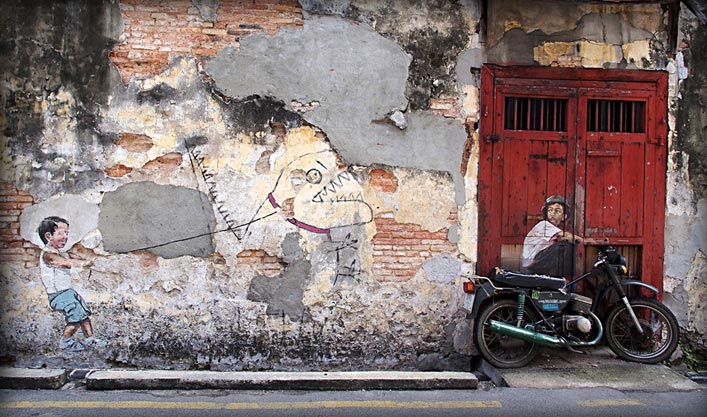
Ernest’s years of hard work are now paying off, he has commissions by major brands including Samsung and Allianz, but there are plenty of artists whose talents still go un-credited or even unnoticed. Next time you’re out marvelling at a mural, take a bit of time to find out who made it, what their story is and what they are up to now.
Promote their work and credit them if you love it. Support it where you can. If you are in a position to commission artists, take the leap and pay them. And if not, take time in researching them a bit. Often, the more context you discover, the more alive the piece of art will be. Just like our little bit of insight about Ernest’s dinosaur, you’ll be part of the little stories behind the postcards.







































